POBLE NOU
The «New Village» of Catalonias capital
is a rough diamond
by Stefan Jermann
premiere issue
discover neighborhoods little explored


issue no 1Poble Nou, Barcelona
-
page 01
cover
-
page 3
EDITORIAL
-
page 7
THE LONE WOLF
-
page 18
INDUSTRIAL TERRITORY
-
page 44
EVERYTHING I LIKE IS ILLEGAL IMMORAL OR FATTENING
-
page 56
CULTURE ON WHEELS
-
page 67
ICON OF PROVOCATION
-
page 83
A WOMAN STORMS EROTIC FILMMAKING
-
page 97
LABORATORY OF RESISTANCE SPARKS ANEW
-
page 117
ARTISTS WITHOUT BORDERS
-
page 128
SHATTERING IDEAS OF ARTISAN CERAMICS
-
page 140
HOME TO TOMORROW'S VISIONARIES
Welcome to the premiere issue of Mirus!
Our vision for this magazine, which is launching into a fast-paced digital world, is to deliver exclusive visual content and compelling storytelling. Mirus wants to make a difference, not only in how stories are told, but also in demonstrating that good works in print can be transported to a digital platform. Over the past 2 years we have fostered a new magazine concept that focuses exclusively on exploring “micro-environments” and we have also developed a digital magazine that will give our readers almost the same experience as touching real paper.
We’ve been working at the intersection of digital immateriality and the pleasure that print provides. And while we’re intrigued by the digital world, we’re addicted to printed matter.
Mirus is about local places with unexpected dimensions. We want to encourage you to explore and to view things from different angles, and sometimes that begins with rediscovering places that we think we already know.
In this first issue we set foot in one of Europe’s most popular destinations. But, as we’ve already mentioned, we like to focus on micro-environments so… have you ever heard of Poble Nou, or in English, "The New Village"? This is probably one of the most fascinating and unspoiled neighborhoods in Catalonia’s capital. A hotbed of creative inventions, a pot pourri of individuals chasing their visions, a colourful and historic place that is multi-layered, multi-faceted and prodigiously poetic.
We hope to hear from you.
Stefan Jermann
Founder, Editor-in-Chief
Navigating MIRUS is a piece of cake, right?




THE LONE WOLF OF CATALAN'S PRODIGIOUS CAPITAL
FLANKED BY THE MARSHY BESÒS RIVER AND MEDITERRANEAN SEA, SANT MARTÍ BEGAN ITS LIFE AS A HAVEN OF FERTILE PASTURES AND LAGOONS. A HUMBLE CONGREGATION OF FARMERS AND FISHERMEN ENJOYED RURAL LIFE IN THIS SLEEPY HAMLET, WORLDS APART FROM THE MILITARY CITY OF BARCELONA. CENTRAL BARCELONA’S MEDIEVAL INSTITUTION OF NOBILITY AND SERFDOM IMPOSED ITSELF PHYSICALLY WITH LOOMING WALLS TO LOCK IN THE POPULATION WHILE COCOONING ITSELF AGAINST ATLANTIC PREDATORS.
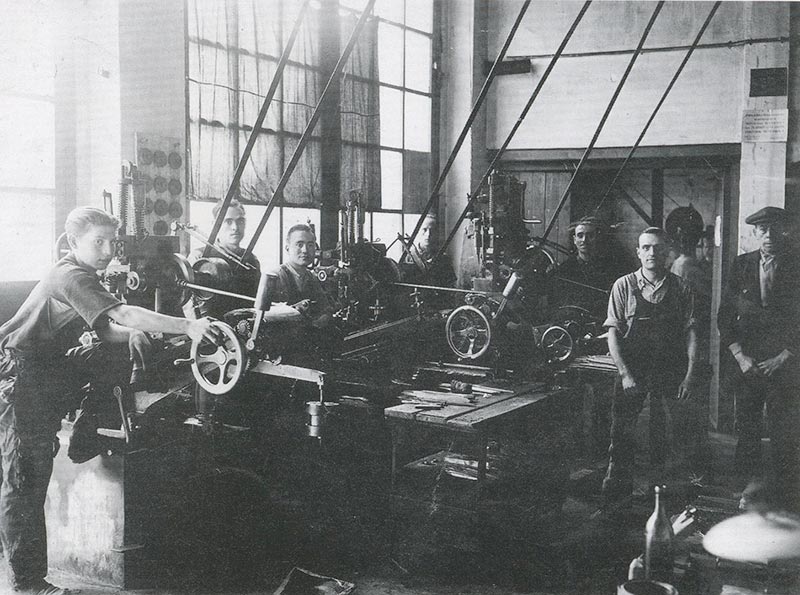
TEXT NATASHA DREWNICKI
PHOTOGRAPHY COURTESY OF ARXIU HISTORIC
On the inside, ambitious master craftsmen and merchants produced hand-made luxury goods for the upper crust using ancient techniques. As scientific learning and artisan trade flourished, businessmen refined their skills, exploring cheaper ways to minimize labor-intensive tasks and maximize output.
The solution would be found in less skilled, lower paid apprentices – anyone who was keen to move up the social scale from peasant or beggar to worker. Combined with rapid technological advances, these first forays into automated processes signalled the end of an old-world regime and the dawn of a capitalist era. The nation’s first entrepreneurs had sown the seeds of industry.
Rambla del Poblenou, main spot in the 20th century. From its origin from the year 1850, the Passeig del Triomf, also known as the Rambla del Poblenou, has been the focal point of the district of Poblenou. This street has always been a perfect setting for all kinds of events: recreational, social, religious or protest.

RAW COTTON AND STEAM POWER
Production and consumerism accelerated at a steady pace. In 1778, the ban on trade with the Spanish colonies was lifted and enterprising businessmen seized the opportunity to import raw cotton.
The backwoods of Sant Martí de Provençals, with abundant water supplies, easy transportation by sea and vastly cheaper land, were suddenly an attractive site to process and manufacture raw materials. Wealthy from the fruits of city trade, the world’s first industrialists took tentative steps towards mass-production by building factory plants in the area. In 1808, there were already 89 factories in Barcelona, 64 of which were to be found in Sant Martí. By the turn of the twentieth century, the area contained a staggering 800 factories.
IN 1808, THERE WERE ALREADY 89 FACTORIES IN BARCELONA, 64 OF WHICH WERE TO BE FOUND IN SANT MARTÍ. BY THE TURN OF THE TWENTIETH CENTURY, THE AREA CONTAINED A STAGGERING 800 FACTORIES.
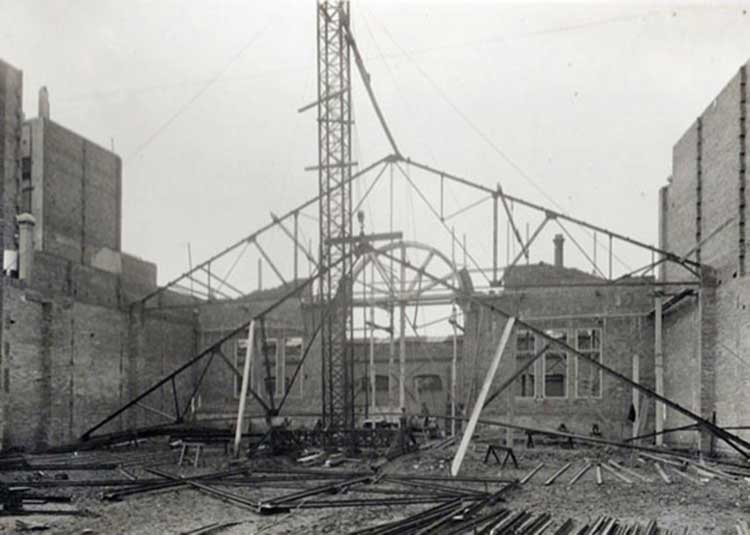
Forward-thinking foreign companies moved in and expanded their roster to manufacture metal, wood, chemicals and food, but textile production dominated the burgeoning economy. As the parish reinvented itself as a new European epicenter for production, competition with other great industries, such as the UK and France, became paramount to its success. Factories created innovative products that consistently wowed buyers -Can Felipa complex was the first location in continental Europe to produce artificial fabrics, while Can Ricart factory kicked off the country’s transition from coal to steam, dramatically increasing production. Sant Martí earned the nicknames of Textilandia, the lungs of Barcelona, and most famously, Catalan Manchester.
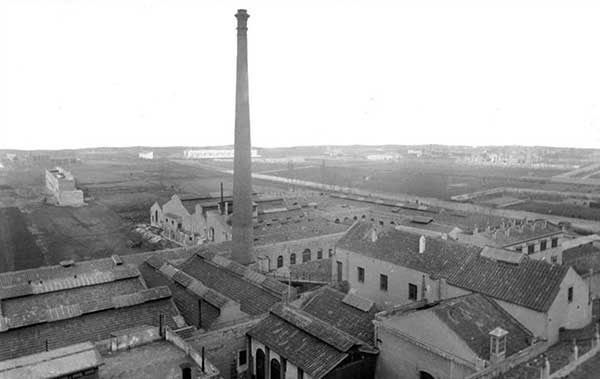
Can Ricart, 1922. One of the largest and most impressive factories during that time.
Now it is home to acllaimed artist in residence hub called «Hangar».
FACTORY WORKERS GAVE THEMSELVES A VOICE BY FOUNDING LABOR UNIONS, CEMENTING THE ROLES OF DOWNTRODDEN WORKER VERSUS CARELESS EMPLOYER.
In this gold rush of opportunity, the surge of immigration sent Barcelona spiraling out of control. Shantytowns orBarracas and worker slums had already mushroomed along the coast and into the hills. Over 40,000 people were squeezed within the confines of the city walls and, as it slowly deteriorated into a squalid hothouse of disease-ridden and illiterate workers, life expectancy reached an all-time low of 19 years old.
By the mid-nineteenth century, industrial workers formed over 60% of the city’s population, with Sant Martí producing over 30% of the country’s gross domestic product. Exploited by militant capitalist employers, marginalized by the government and exasperated by dreadful living conditions, a backlash brewed. Factory workers gave themselves a voice by founding labor unions, cementing the roles of downtrodden worker versus careless employer. Violent strikes and protests became a regular occurrence and Poble Nou cemented itself as one of the city’s strongholds for socialism and anarchism. To this day it identifies itself as Barcelona’s defiant sibling.
Meanwhile, a small group of Icarian* factory workers, who, following the socialist doctrines of French Étienne Cabet, formed a community on the strikingly beautiful, whitewashed sanctuary of Plaça Prim - a world away from the grey, billowing factories nearby. While never greatly influential, they represented utopian ideals of social transformation and equality that the marginalized classes could still only dream of. In the centre, capitalists of the industrial revolution were now millionaires and built towards the upper echelons of the city to flee the wrath of indignant workers elsewhere in the city. During the boom, great Modernist architects such as Gaudi embellished the thoroughfare, Passeig de Gracia, with architectural masterpieces. Today the northern neighborhoods of Barcelona are still a safe-haven for the upper classes while gritty labor districts, including Poble Nou, cling to the coast.
* The Icarians were a French-based utopian socialist movement, established by the inspired readers of the politician, journalist, and author Étienne Cabet (January 1, 1788 – November 9, 1856). He was a French philosopher and utopian socialist. He was the founder of the Icarian movement. His goal was to replace capitalist production with workers.
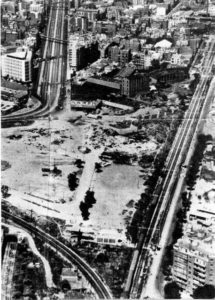
Avenida Meridiana around 1920. At this time there was a fully functioning tram system operating on Meridiana. The tramway disappeared when the urbanization was on full scale starting at around 1964. The Avenida Diagonal still operates a very modern tram starting on Placa Glories and taking you all the way to the beach.
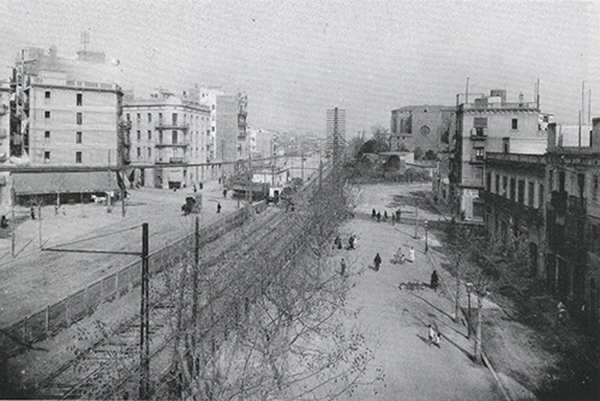
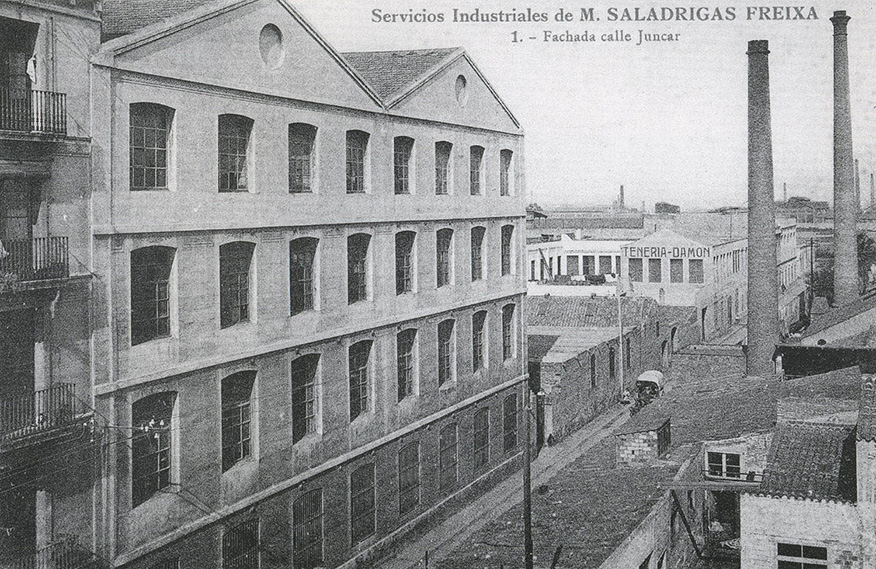
Fábrica de Can Saladrigas Freixa, 1916. This textile factory was founded in 1860 and occupied the island formed by the streets Llull, Lope de Vega, Joncar and Marià Aguiló.
Something had to be done to control growth. In 1840, the council asked its public, “How would Barcelona and its industry benefit from the demolition of our walls?” Filip Monlau won the competition, urging the city to absorb the surrounding countryside as its own by highlighting the psychological and physical relief una nueva Barcelona would bring to its people: Poble Nou, Pueblo Nuevo or the new village, was christened as the city’s newest barrio.
Finally, in 1859, the walls were demolished and a bloated Barcelona could begin to recover. The government hired Ildefons Cerdà, a Catalan engineer, to impose rational order on the ramshackle urban layout and absorb neighboring villages, including Sant Martí, into a modern urban metropolis.
“If Barcelona expands into the provinces, anything is possible! We’re within our rights to insist on living in the fresh air, with the open space that our health and professions demand!”
His plan highlighted the newfound respect the area had earned as an economical powerhouse. A new avenue (Avenguida Diagonal) would carve through the city diagonally - Poble Nou was poised to become the city’s new core. Cerdà’s garden city was designed as a breath of fresh air for Barcelona’s increasingly toxic environment and encompassed every imaginable component of ordered living: Spain’s first railways, large-capacity sewers, horse-drawn trams, gardens and pedestrian areas.
Ultimately though, Sant Martí failed to become the city’s new nucleus for one simple reason: workers and factories lived there, but Barcelona’s Eixample district was home to commerce, with its abundance of shops, impressive architecture, and well-heeled residents. Instead, Sant Martí became one of Barcelona's major road and railway junctions, shuttling freshly made products to and fro. No longer considered a frontier, at the turn of the twentieth century, the city officially absorbed it as l’últim barri, the final neighborhood.
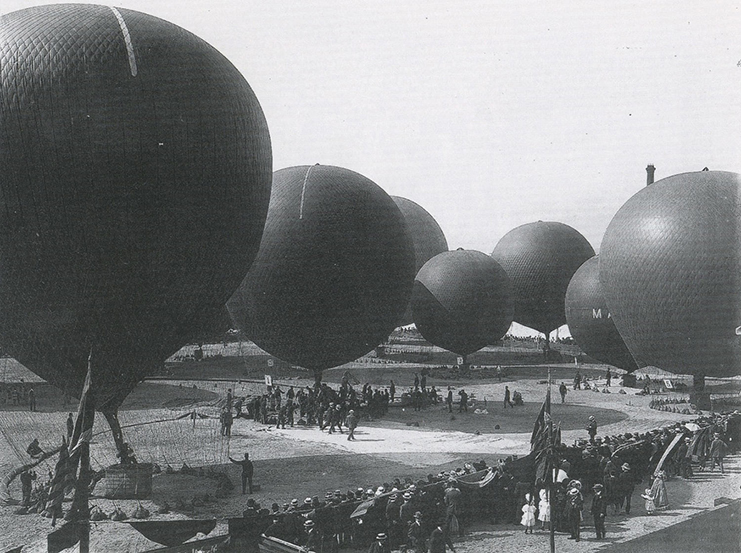
Balloon contest on the beach of Marbella, 1907. Events like that were a clear sign for the economic uprising.
The industry had ripened into a well-oiled, global machine but eventually, international competition and a burgeoning global economy proved too fierce. By 1963, more than 1,300 businesses closed their doors and a quarter of the population had already relocated. After Franco’s death in 1975, a newly open economy secured the final nail in the coffin for Poble Nou’s industry. As the neighborhood ceased to provide a steady source of capital, the government lost interest. Factories and warehouses were left to deteriorate and the area gradually slid into dereliction.
“… now that communism has gone down the drain, why not convert its dream into a Disneyland theme park for the new bourgeoisie?…A model of the perfect communist city, without the disasters of the communist cities whose collapse we have just witnessed?”
Vázques Montalbán
LA NOVA ICARÍA, URBAN DISTOPIA
The spacious, empty factories attracted an altogether new type of worker. Free-spirited artist and music workshops, theatres and acrobat studios replaced tired factory obreros who had trundled the same factory compounds a hundred years earlier. Graffiti adorned crumbling walls and colorful caravans resided in communal spaces, and a grassroots community blossomed in the disused buildings at little to no cost. Were they compensating struggling workers’ lost freedom a hundred years earlier?

Historic hand drawing showing part of Sant Martí de Provençals, 1714.
In 1980, Barcelona secured the 1992 Summer Olympics. Poble Nou was singled out as the site of a new Olympic village and urban regeneration project, a springboard to showcase the city as talented international player once again. It would epitomize the transformation of the entire city and gentrify the scruffy, lower-class barrio of Sant Martí. La Nova Icaría – the government’s multi-billion-dollar interpretation of a new Icarian dream – comprised immaculate beaches, new apartments, skyscrapers, stores, bars, restaurants, offices and a beach boardwalk.
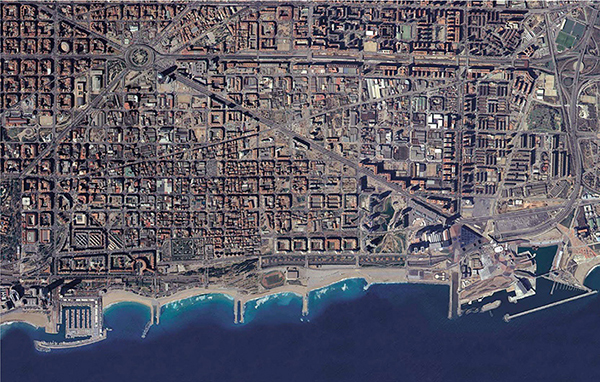
Plaça de les Glòries was originally intended as a large public square in a new city centre, but it remained sparsely developed, turning into one of Barcelona's major road and railway junctions. Below is an areal shot of Poble Nou reaching from Gloriès to all the major beaches.
“… it was hard to tell where the destruction ended and where the construction began. Cranes, big piles of earth, bulldozers, leveled building plots, foundations for new flats, like the shoots of bulbs peeking out from beneath the membrane of the dead earth, a flat surface of hints about what the Olympic Village was going to look like after a year or eighteen months, between the bare, ugly sea and the terrorized leftovers of what remained of Pueblo Nuevo [Poble Nou]…"
José Pepe Carvalho was a literary figure of acclaimed writer Manuel Vázquez Montalbán (1939-2003).
In the giddy excitement to attract tourists and investors to the area, urban planners overlooked the organic collectives, entering a sort of collective amnesia by bulldozing factories in an attempt to eradicate sore memories of a failed capitalist dream. There was no plan to conserve the factories, nor had private real-estate speculators consulted with the council before tearing down many of the publically owned buildings.
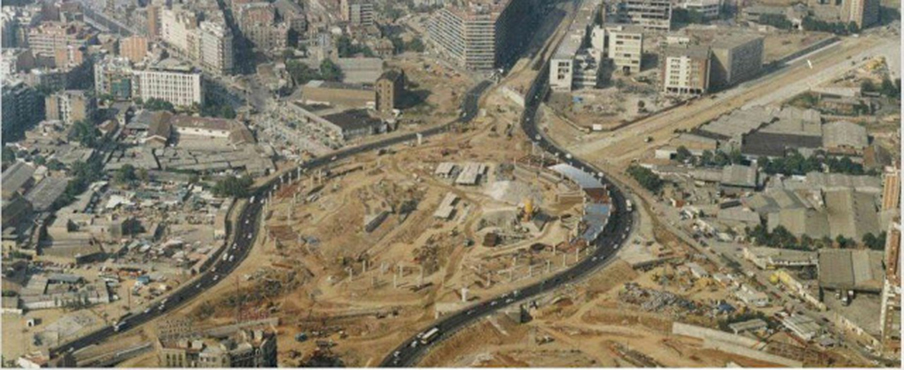
Plaça de les Glòries during construction.
Locals were horrified to see so much memory stripped away and campaigned for protection of many of the buildings, by now historical artifacts. Despite tensions caused by the Olympics, they were an overwhelming global success, cementing the city’s future success to rival London, Paris or Rome. The area was ripe for investment and continued renovation and in 2000 a new »22@ district of technology plan« would continue to reshape the economic and physical landscapes of Poble Nou.
This unassuming neighborhood has experienced more production, construction, revolution, migration, dereliction and regeneration than perhaps any other European city. Is this the perpetual curse of being called The New Village, despite being subjected to more disruption in two hundred years than entire cities might in one thousand?
THE AREA WAS RIPE FOR INVESTMENT AND CONTINUED RENOVATION. IN 2000 A NEW «22@ DISTRICT OF TECHNOLOGY PLAN» WOULD CONTINUE TO RESHAPE THE ECONOMIC AND PHYSICAL LANDSCAPE OF POBLE NOU.
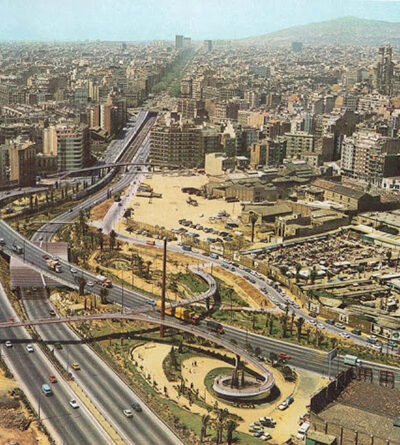
INDUSTRIAL TERRITORY AS A MELTING POT FOR CREATIVE ENERGY
PORTRAITS STEFAN JERMANN
TEXT MANON HOLZER
Poble Nou "Urban District" identity was designed by Ruiz+Co. as an initative to boost Poble Nou.
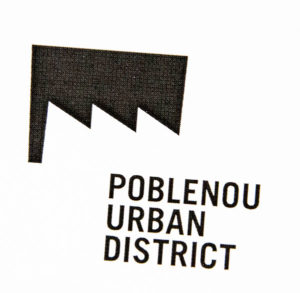
WHEN CITY OFFICIALS SET OUT THEIR PLAN FOR THE «22@» MOVEMENT, THEIR AIM WAS TO ATTRACT GLOBAL FORTUNE 500 PLAYERS FROM THE HIGH-TECH AND COMMUNICATIONS INDUSTRIES. WHILE SOME OF THESE COMPANIES DID COME, THE RADICAL INDUSTRIAL FEEL OF THE BARRIO ALSO ATTRACTED CREATIVE TYPES IN DROVES. ANOTHER ATTRACTION WAS THE MODERATE RENT FOR GENEROUSLY PROPORTIONED SPACES.
OLD FACTORIES WERE TURNED INTO CREATIVE STUDIOS, LIKE THE IMPRESSIVE PALO ALTO, A FORMER INDUSTRIAL COMPLEX WHERE STAR DESIGNER JAVIER MARISCAL AND OTHER LEADING CREATIVES NOW WORK, OR DAVID RUIZ’S SPACIOUS LOFT STUDIO, WHICH OVERLOOKS THE ENTIRE DISTRICT. WE MET AND TALKED TO THESE FOLKS AND CAME AWAY AMAZED AT THE HIGH CALIBER TALENT CONCENTRATED IN SUCH A SMALL AREA.
ALBERT FOLCH // GRAPHIC DESIGN
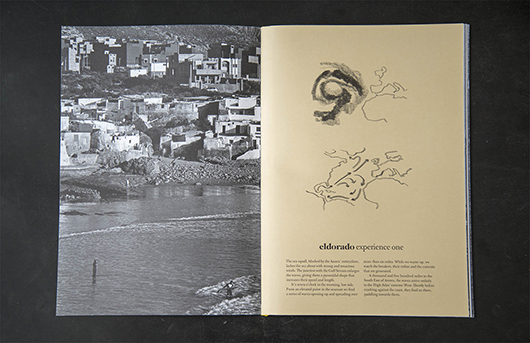
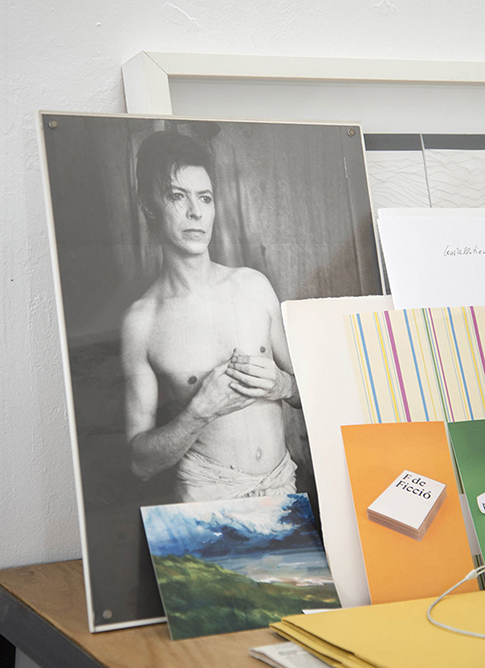
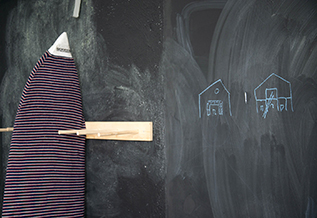
ALBERT FOLCH'S STUDIO JUST HAPPENS TO BE ONE OF SPAIN'S MOST CUTTING EDGE EDITORIAL HUBS. FOLCH IS THE ORIGINAL DESIGNER OF ACCLAIMED APARTAMENTO MAGAZINE, THEY DESIGN FOR MARSET AND MOST RECENTLY HAVE LAUNCHED AN UPMARKET EROTIC MAGAZINE CALLED ODISEO.
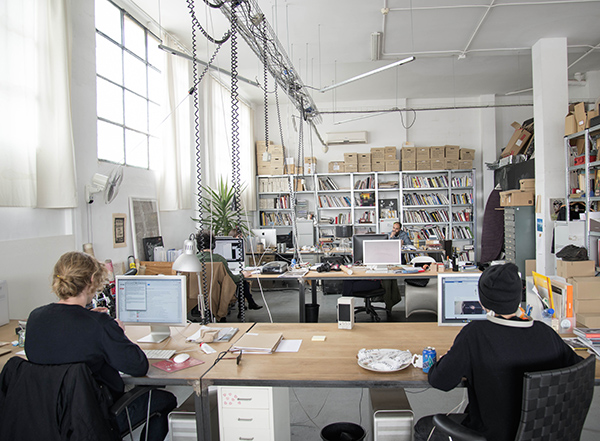
The Loft office space of Albert Folch is in the heart of Poble Nou. The generous studio is shared together with an architecture firm next door.
At a time when books and magazines fall into the dying industrycategory and publishers are looking for alternatives and a leap into the digital age, amazing things seem to be happening. And they are definitely happening in the heart of Poble Nou, at number 31 on the Carrer de la Ciutat de Granada to be exact, a very unspoiled corner of the barrio.
It is my very last day here in Barcelona, and yesterday I was with ceramicist Xavier Mañosa who was telling me about Albert Folch’s Studio. I send a message to Folch and get a prompt reply sometime after midnight inviting me to come over, and I’m basically crashing the place last minute. Unfortunately, acclaimed editorial designer Albert Folch is travelling in Panama for his latest venture, Eldorado Magazine, but his business associate Rafael welcomes me.
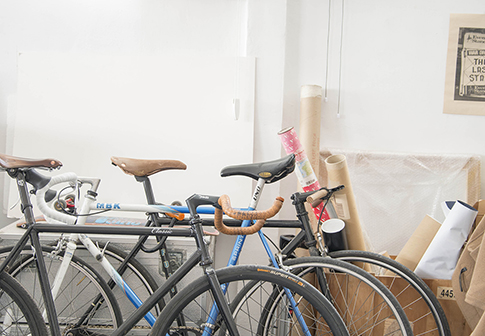
It’s still a bit early, but the bright daylight in the loft style office wakes me up fast. Albert Folch, former geologist, drop-out photography student turned editorial designer, co-founder of Apartamento magazine, one of Spain’s jewels and most radical cats, has a portfolio of international clients. While I shoot some pictures of the office, Rafa shows me their latest invention, Odiseo, an erotic magazine that is more like a book, a showcase for intriguing and tasteful photography and art. You can see that the work has been carefully edited and it gives the term erotic magazine a whole new meaning. Odiseo almost feels like a personal journal, something precious you won’t be throwing in the next trash bin. In fact, Rafa tells me, the current issue is sold out. Albert’s newest magazine, Eldorado is for surf afficionados, though looking through it, there’s not much to do with surfing: it’s really more of a conceptual piece, reduced to the max, with barely any design elements. The black and white images are unexpectedly simple, and that is exactly the beauty of it. No surfers riding the waves, instead I see rocks, beautiful skies — everything that could imply surfing. I decide this is poetry, maybe because I have always admired people who, when they want to portray an apple, don’t have to show an apple. Albert and his associates seem to be people like that. In fact, as I find out, they are folks with an uncompromising vision.
VISIT FOLCH STUDIO
I have an interesting chat with Rafael who oversees the business side and strategy: “We need to have creative freedom when we take on projects: the client has to trust us.” The studio, with its six or seven employees juggles anywhere from 20 to 30 projects at the same time. International projects such as one for Carolina Herrera in New York, a big book project for a client from Chicago, and jobs for clients in Spain fill their impressive portfolio. When I ask about potential dream clients, some of Folch’s graphic folks gather around and roast their brains. One young guy explains that the dream project is always something you identify with, products you admire and buy yourself. But what about client constraints, reduced budgets — I can hardly assume the Folchs have never encountered such things? “Yes, we feel all that, we can’t deny it”, says Rafa, but he points out that the crisis has been very good for their studio, because now, instead of spending big old advertising money, brand owners are starting to think differently and want to try to tell their stories via editorials, rather than using classic advertising. “You know, in the end it’s not so much about magazines and good design, it’s much more about developing an interesting concept that could develop in any possible direction.”
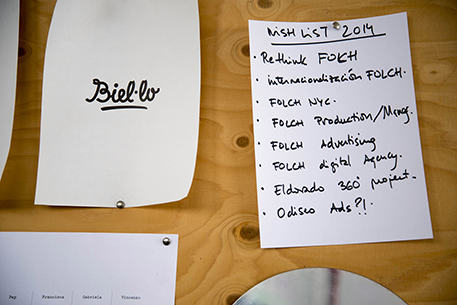
The Folch's wish- and dream list for the current year. The office as a source of inspiration. The light falls in gently thru the high windows.
«INNOVATORS LIKE US WORK AS HARD AS WE CAN TO MOVE FORWARD WITH OUR OWN PROJECTS, CREATING POSITIVE SYNERGIES AND NEW BUSINESS MODELS.» Albert Folch
PALO // ALTO

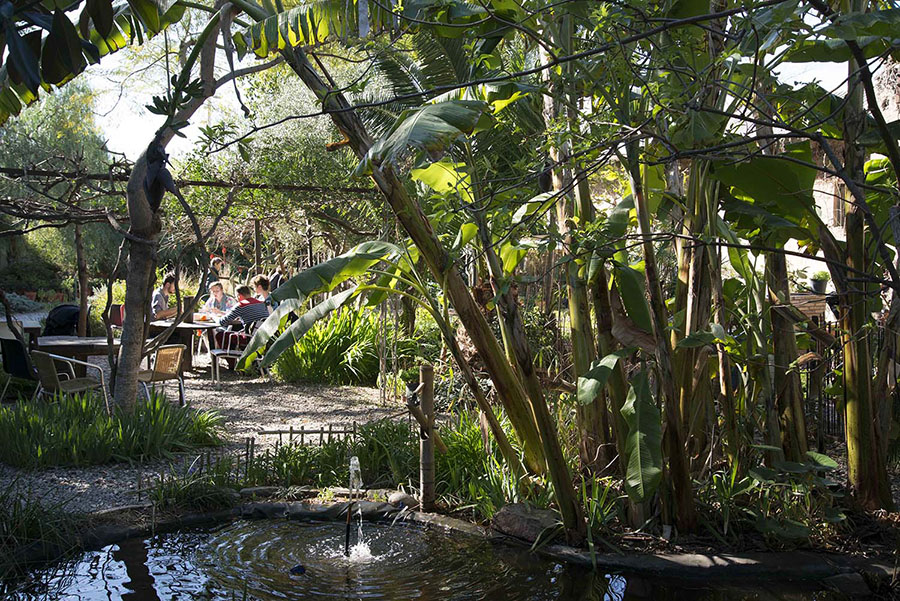
THIS LITTLE GREEN HEAVEN IS OPEN TO THE PUBLIC
SOME TWO DECADES AGO, JAVIER MARISCAL DISCOVERED AN ABANDONED FACTORY IN POBLE NOU THAT WAS COMPLETELY DERELICT. HE DECIDED IMMEDIATELY TO MOVE HIS STUDIO THERE. NOW, PALO ALTO IS NOT ONLY HOST TO SOME OF SPAIN'S MOST REVERED DESIGN STUDIOS, BUT IS ALSO ONE OF BARCELONA'S LUSHEST AND MOST IMAGINATIVE GARDENS, DESIGNED BY JOSÉ FARRIOL.
When Jobs and Wozniak started out in their garage, could they ever have envisioned the impact of their - let’s call it tinkering? I assume not, even though Jobs later developed almost fortune-teller-like abilities, predicting how a generation would function and what their needs would be. The origin of all this was an unstoppable, and maybe naïve, passionfor a cause that they believed in: a story very similar to Javier Mariscal’s. He started out as the pioneer underground comic artist in Spain, and after his work was confiscated by the regime he turned his hand to graphic design, went on to design his own furniture pieces and became a multi-tasking whiz, ultimately attaining super-stardom with the corporate design for the Barcelona Olympics and the Game’s mascot. A few years later, when he found an abandoned factory in Poble Nou, he seized the opportunity to restore it while preserving its heritage and history, to become one of Barcelona’s most beautiful creative spaces.

Palo Alto is a unique environment, the factory loft with its bouncing light is a heaven for creatives.
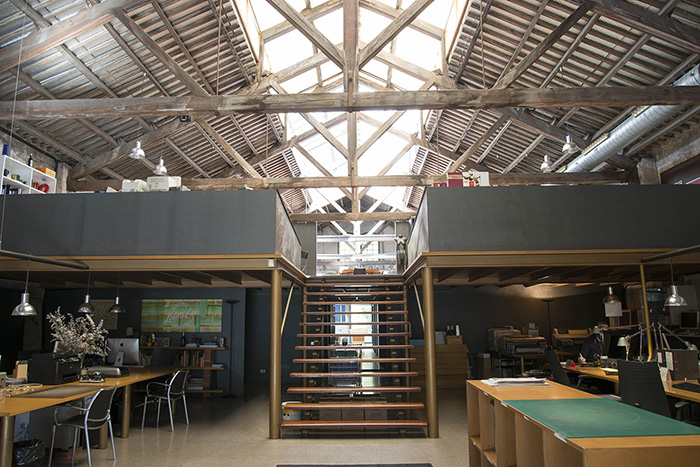
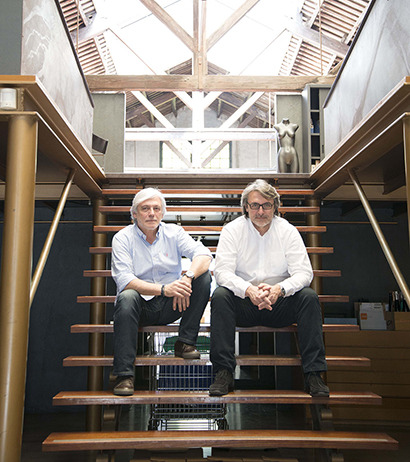
Designer Josep M Morera and his business partner on the stairs of their impressive studio at Palo Alto. The main structures of the old factory have been well preserved with lots of daylight flooding in from every angle.
The name Palo Alto may be a nod to the place Jobs called home, and perhaps also a reference to Silicon Valley’s inventions, innovations and daring visions. Palo Alto is an oasis and every creative’s dream workspace. It has the surprising coziness common to many old factories, while the interiors are sleek, modern, and minimal. I am greeted by Mariscal’s secretary and she tells me that Javier is out of town, but I am welcome to look around. After all, I just discovered the place by accident and I hadn’t made an appointment with one of the world’s most award-winning designers. Trophies and awards are everywhere, the office is colourful, as are his drawings. His work has a resonance, the Mariscal signature style, some of the drawings, posters and books I spot have a child-like whimsicality, yet they are commercial. When fine art meets the capitalist advertising world, and the marriage works out, then you’ve killed two birds with one stone. Mariscal is doing exactly that and he seems to be doing very well..
Palo Alto is often mentioned in association with Javier Mariscal and some of its other star occupants, but it is equally renowned for its lush, green gardens, which are open to the public. This really is an urban island, a small oasis created by acclaimed landscape designer José Farriol, who turned the space into a peaceful spot for relaxation. If you want to escape the tourist masses, this is the place to go for some quiet time and a bite to eat at the Palo Alto Cantina.
ELI // GARMENDIA
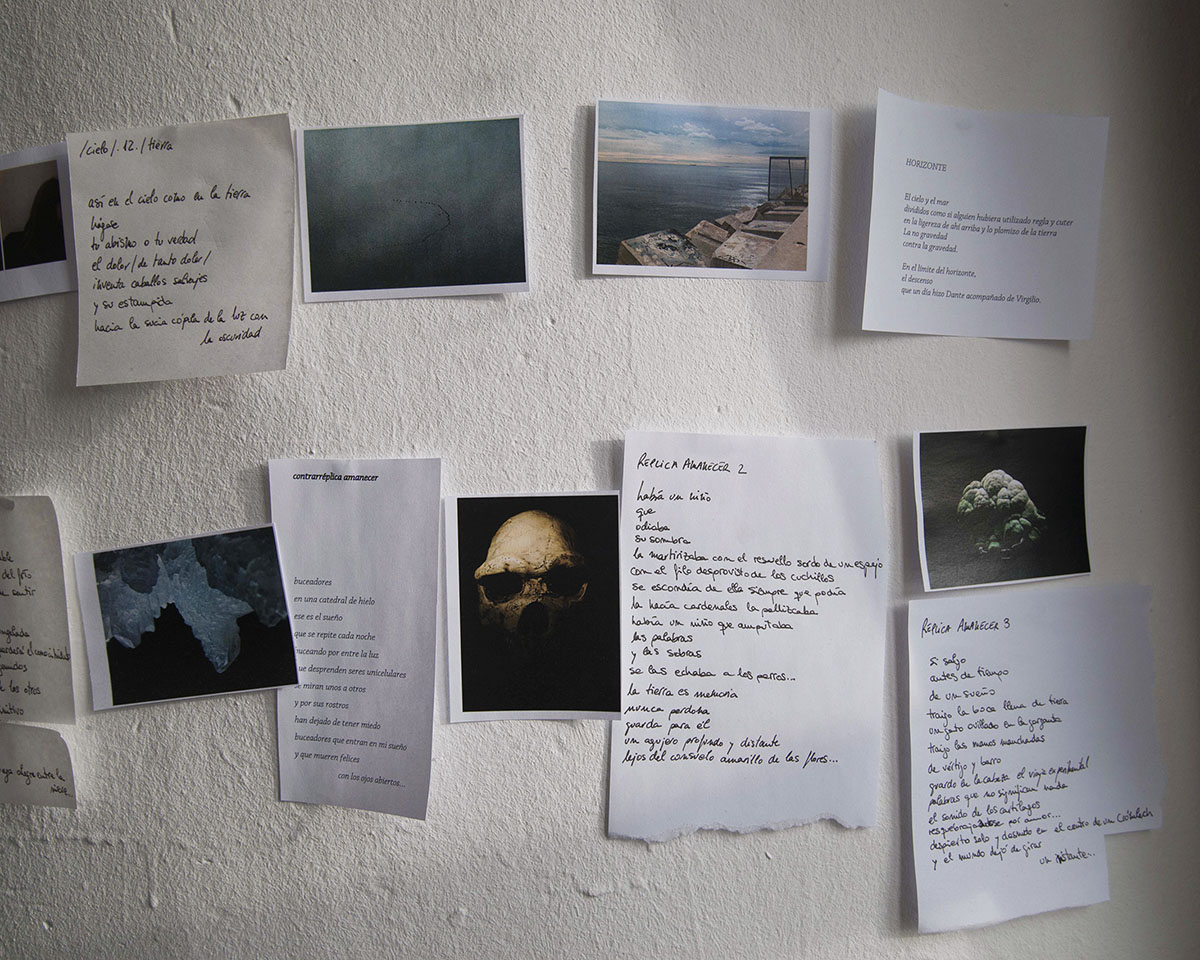
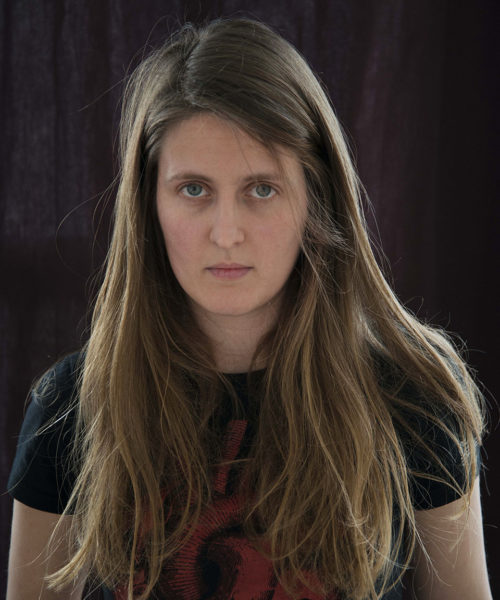
THERE IS A »CINDY SHERMANESQUE« QUALITY TO HER IMAGES AND I ASK WHAT THIS PROJECT IS ALL ABOUT. “THE IDEA IS SORT OF A CONCEPTUAL POETIC EXCHANGE BETWEEN WRITER ROBERTO RUIZ ANTUNEZ AND MYSELF,” ELI REPLIES.
I was referred to Eli via a mutual friend, I was specifically looking for people living in Poble Nou and I wanted a ‘female creative’. This may sound strange, but the photography business, even in Spain is male dominated. Period. Don’t ask me why. Eli is from the Basque region, a place where people have a different mentality, their own mind-set. A bit stubborn maybe, a bit closed off, but once you have earned their trust, they are yours. She shows me around her place, which she shares with another artist. In the kitchen, motorcycles are everywhere and there are bicycles next to iron sculptures. Interesting combinations. In Eli’s room I spot pictures on the wall, self portraits. I see blood on her face, a naked body, skulls and I understand that she has an enormous talent to transforming herself.
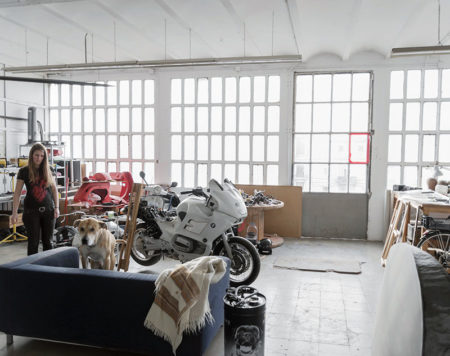
Eli in her 'living room' with her roommates dog. This former warehouse is located on Avenida Pujades, in the heart of Poble Nou.
There is a Cindy Shermanesque quality to her images and I ask what this project is all about. “The idea is sort of a conceptual poetic exchange between writer Roberto Ruiz Antunez and myself. I take a picture and Roberto writes a poem and sends it to me or vice versa.”The result is quite an impressive collection of poems and photographs. The outcome is unclear, but right now it is more to do with the process, rather than about making an exhibition or a book later on. Besides her personal projects, she is working as a commercial photographer and is focusing full time on that right now. Before, she was teaching elderly people how to use Photoshop and doing other occasional jobs, but now she feels the time is ripe to focus on just one thing.
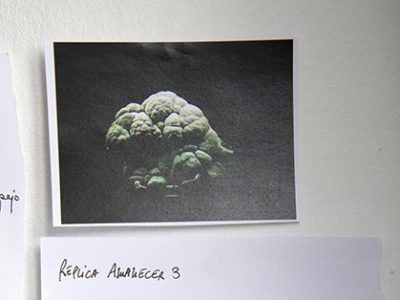

A personal project of Eli in conjunction with poems of death, pain, love and life.
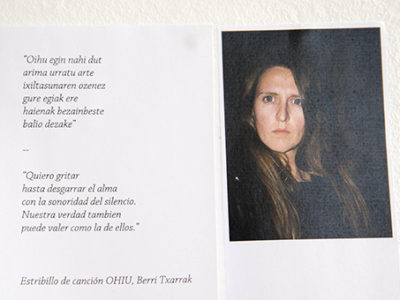
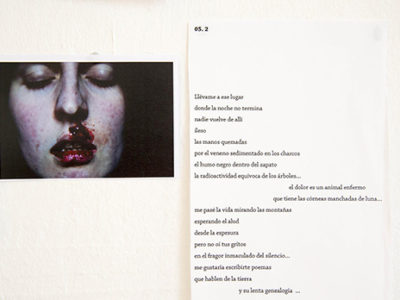
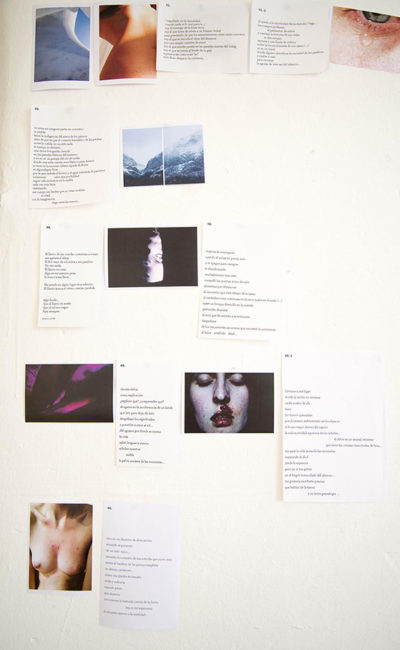
LA // GRANJA
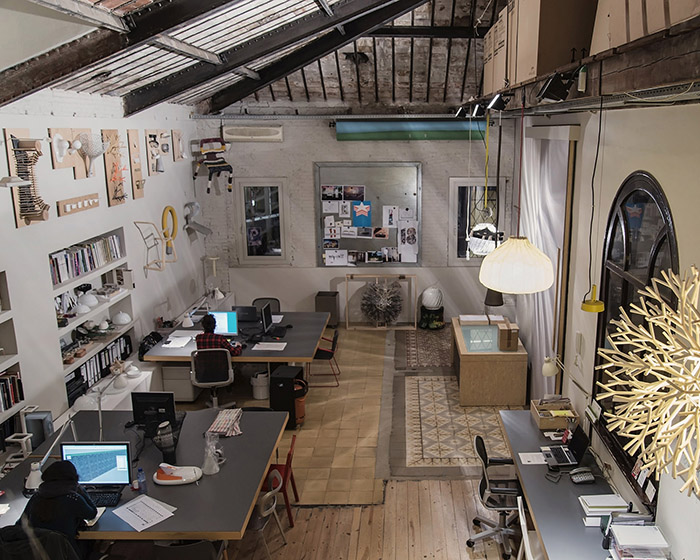
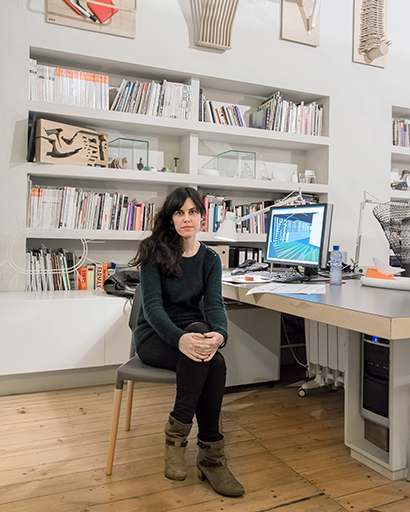
FROM A MALL IN CHINA, TO DESIGNERS CHAIRS, LIGHTING AND WORLD CHAMPIONSHIP MEDALS. LAGRANJA IS «A JACK OF ALL TRADES» IN THE TOP LEAGUE OF PRODUCT DESIGN.
I love to crash people’s places without an appointment, and it works shockingly well here in Poble Nou. I ring the bell: “Yes, sorry for disturbing you, but I was wondering if I could stop by and take some pictures, ask you some questions, this is for a new magazine called Mirus.” “Sure - come on in”, Maria greets me, and I start explaining my presence and my purpose. After taking some shots I sit together with Maria and we chat. Next door, the management has a big meeting, so nobody is around. Perfect timing.
Lagranja is an industrial and product design company and their range of designs goes something like this: chairs, lighting, the winners’ medals for 2013 swimming World Championships, entire shopping mall hallways in China, and the interior design of the penthouse suites in a new luxury hotel in Hong Kong. Maria lists what they do as if it were the most common thing in the world. When I wonder aloud about people coming all the way from China to Poble Nou for shopping mall design, Maria answers: “The Chinese don’t have the same flair for colour as the Europeans do, and that’s what they like about us.”
We chat a bit more and what filters through is that while the economic decline is slowing the business, at the same time it is opening new doors. Right now lagranja is establishing offices in Hong Kong and Istanbul, two hot spots for conquering the Asian market. Lagranja has been in Poble Nou for seven years. The crew seems to enjoy it here, it’s quiet, an ideal work space, has creative energy. The only downside is the vast emptiness on the streets at night, says Maria.
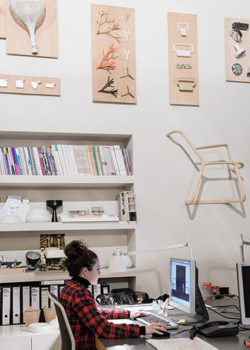

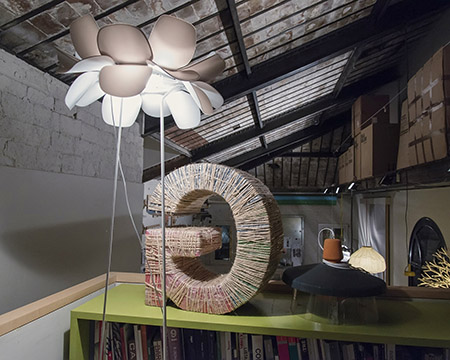
// RUIZ + COMPANY
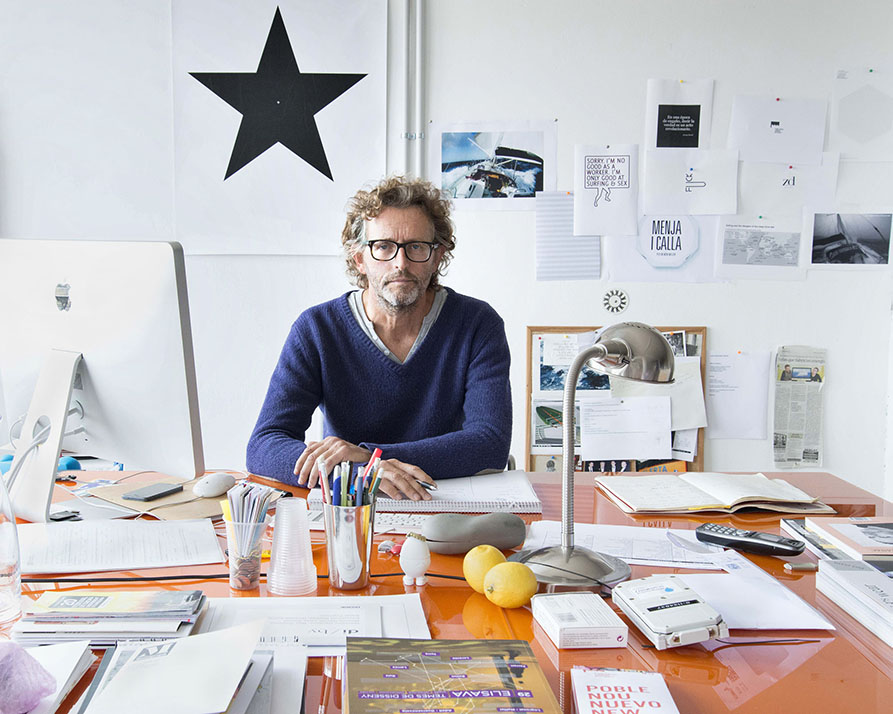
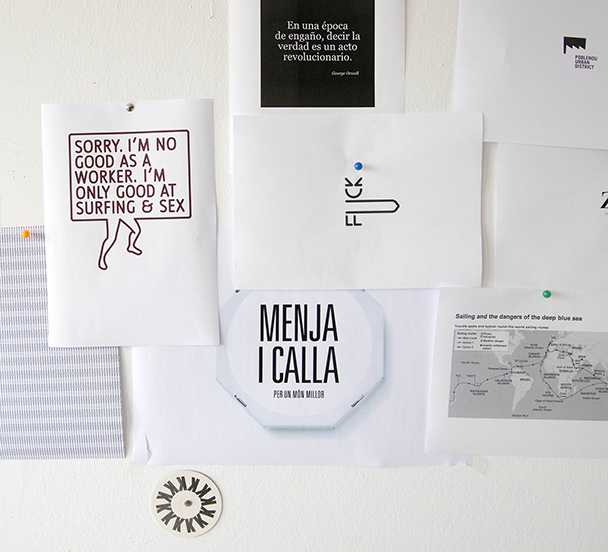

«WHETHER DAVID RUIZ IS ON A BIG PHOTO SHOOT WITH SUPERSTARS LIKE TERRY RICHARDSON OR MARIO SORRENTI, OR DEVELOPING A NEW BRAND IDENTITY FOR A CLIENT IN DUBAI, THIS MAN’S HUMILITY IS INSTANTLY PALPABLE.»
Building 71-75 on Calle Avila, where Ruiz + Company is located, has a nondescript character. It might have been a warehouse in the old days but now it houses offices, and in the attico, one of the most reputable design studios in Barcelona. The studio deserves the descriptiondesigner’s loft in every respect. One huge, light flooded and welcoming space with a motorcycle parked right by the entrance, apparently ready to be taken for the next creative ride. Checking out the walls, you notice that Ruiz has probably won every creative award there is, and there are good reasons for this, as we are about to find out. The space is well organised, there is a lounge area, a ping pong table and a big balcony for relaxing and enjoying the views to the sea and right up to the ‘Torre Agbar’.
Ruiz & Co. creates identities, but they also apply their graphic design to packaging design as here for a new health juice
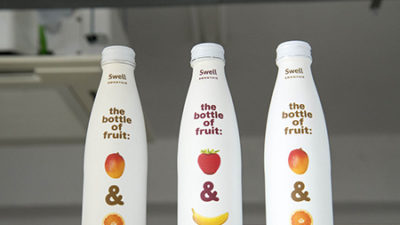
The charismatic founder of this small yet thriving studio, David Ruiz, has been operating his venture for some 20 years, along with 5 team members. These are people that he trusts and can very much depend on, whether he is working on a big project for Camper, Audi or Tous – or whether he is far away, crossing the Atlantic Ocean alone on a 20 day journey in challenging waters. (Not many people have actually done that, I discover after our meeting.) The studio is multi-disciplinary and focuses on graphic design, packaging, identity and advertising. In talking to this man, one quickly realizes that he really lives design. Ruiz always aims for the best and the highest quality, and that is why Ruiz + Company only works on a project basis. In contrast to large advertising agencies, Ruiz is not interested in big accounts.
This is a very conscious strategic decision, and David tells me he is very selective about the projects he takes on: only those with an interesting brief and only from clients who are looking for the highest creative qualities. When asked if he has had to turn down jobs because of his scruples, he smiles and says: “Oh yes, many times, many times. You know, of course we want to eat and pay the rent, but we also want to stay true to ourselves. When a potential client approaches us now, they usually know what kind of work we are capable of delivering.”
David is influenced by the work of: Tibor Kalman, Editor in Chief and art director of Colors Magazine; Terry Jones, the founder of iD Magazine; and Saul Bass, the American graphic designer and filmmaker.
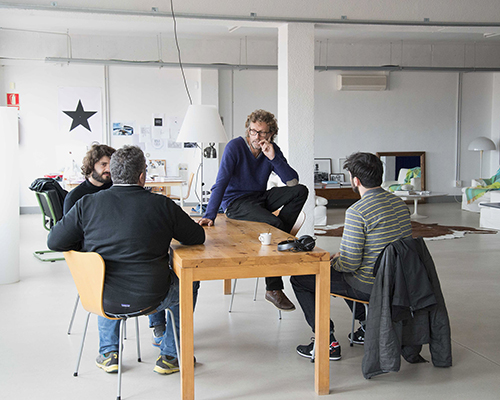
Whether David Ruiz is on a big photo shoot with superstars like Terry Richardson or Mario Sorrenti,or developing a new brand identity for a client in Dubai, this man’s humility is instantly palpable. He is enveloped by a trustworthy vibe. And when asked how it was working with Terry, he answers: “Well, you know, at first I was a little worried how this would all turn out, but Terry was very good to work with and the team surrounding him is highly professional. We did this shoot in New York and it was a great experience.”
When talking about Poble Nou his eyes sparkle and he admits to having fallen in love with this neighbourhood, even though he didn’t like it at first. He says it’s the industrial feel of the place, the closeness to the beach and being in a creative environment that creates a good mix. As he points out: “Fifteen years ago Poble Nou seemed way too far from the city, but now, all the creatives are coming here!
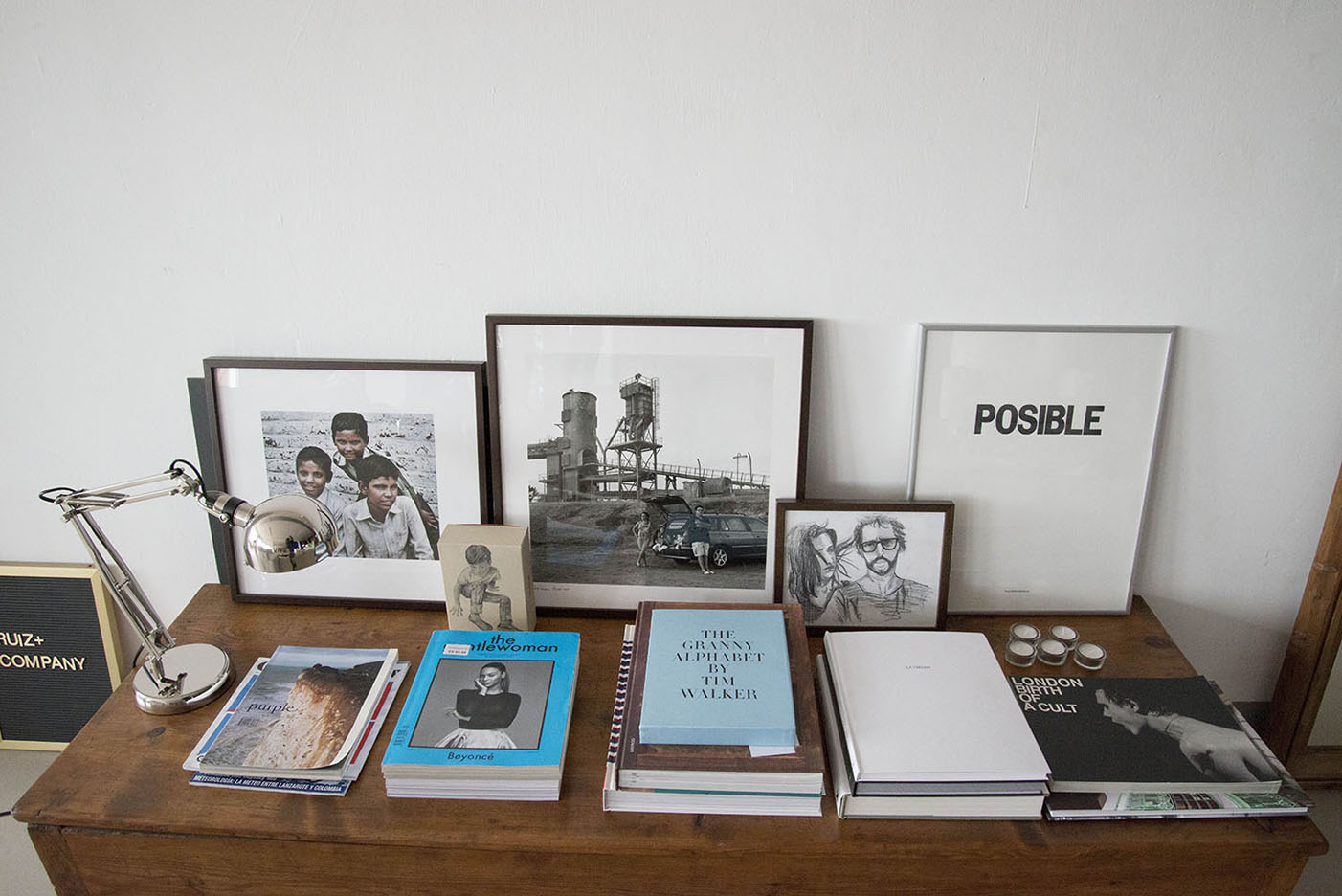
The city’s idea behind the huge Poble Nou development was to create a high tech hub, mainly for IT companies. Some of them did settle here, but never as many as they expected. What came as a surprise was the number of people in the creative field that were attracted here, and it’s an excellent side effect.”
// WASSABI + H2o
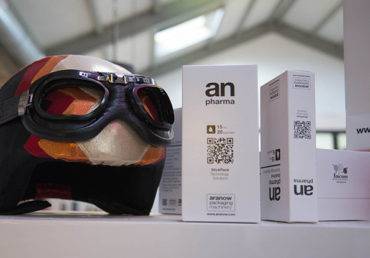
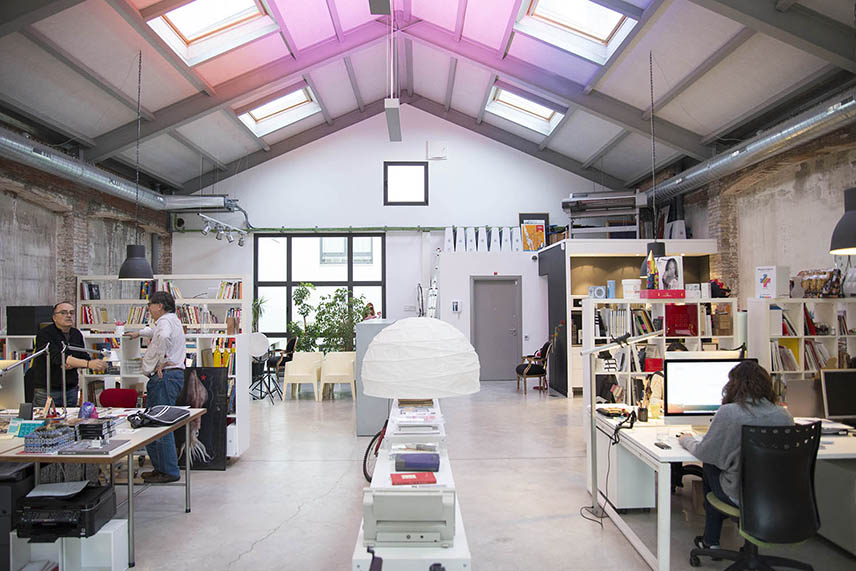
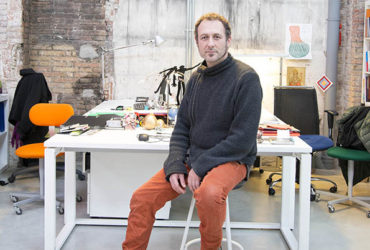
When Wassabi & H2O took over the penthouse floor, they restored the office by themselves, giving it a modern spark, but leaving the old, washed out walls that are a century old.
At Carrer de Roc Boronat 66 there are two design collectives that share an amazing penthouse space, and at times, they also share their knowhow and workforces. While Wassabi is more oriented towards graphic design, packaging and product design and was responsible for designing a campaign for the European Parliament, h2ò is a branding company with a portfolio that includes multinational clients. Enric of Wassabi and Lluis of h2ò couldn’t be more different in appearance: Enric is every inch the creative type, while Lluis better fits the description of a creative strategist.
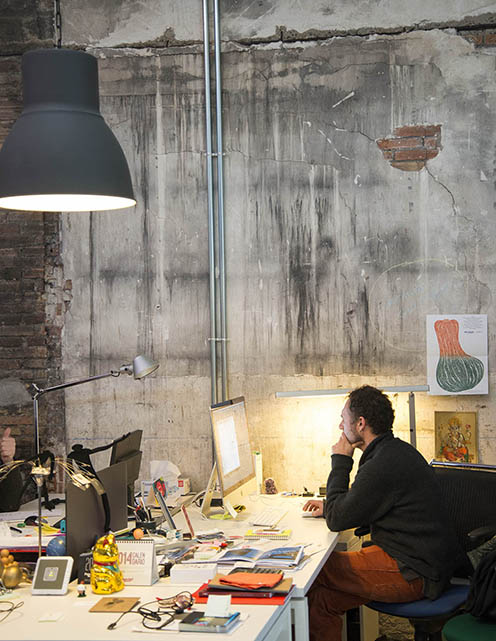
As we enter their studio, things are hectic: times are very busy says Enric. At the mention of Spain’s economic woes and unemployment close to 10 million, he raises his eyebrows. While admitting that everyone is feeling the pinch and that the economic situation is difficult, and that clients are more hesitant, he says that a lot of new projects have come as a result of their own initiative. “We don’t wait until a client gives us work: we are pro-active, we suggest new ideas and projects to clients, give them ideas on how they can improve their business and products.” Lluis adds that while the economic downturn is a fact of life, he can’t complain: there’s been so much work coming in, they had to hire three more staff.
To Enric and Lluis, Poble Nou is a blend of tradition and innovation, and they both really love the area. They see more and more creatives settling in Poble Nou, and while they were the first creative studio in the building a few years ago, other designers have since moved in. And there’s a notable absence of competitive elbowing between companies. When we ask Enric which other top creatives we should talk to, he mentions David Ruiz…
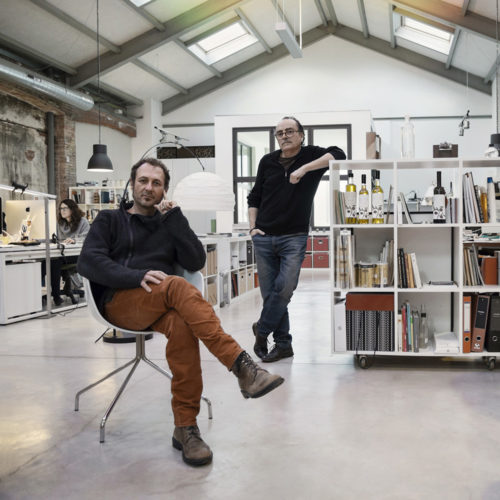
Enric Lopez of Wassabi and Lluis Ayguadé of H2ò Communication.
We've asked Lluis (right) about his top three creative influences:
Milton Glaser
Pentagramm Studios
Ricard Giralt Miracle
«Everything I like is illegal, immoral or fattening.»
«TODO LO
QUE ME GUSTA
ES ILEGAL, INMORAL
O ENGORDA.»
NyamNyam
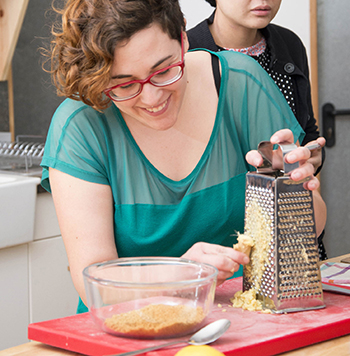
The guests at NyamNyam are invited to participate
during the cooking process.
Story Natasha Drewnicki
Photography Stefan Jermann
ALL RECIPES + DRAWINGS COURTESY OF NYAM NYAM
WHEN ARIADNA RODRÍGUEZ, HER PARTNER IÑAKI ALVAREZ AND THEIR ONE-YEAR OLD DAUGHTER MOVED TO POBLE NOU IN 2012, THEY STARTED LOOKING FOR ALTERNATIVE SOURCES OF INCOME ALMOST IMMEDIATELY.
"OPPORTUNITIES IN OUR CREATIVE FIELDS HAD DIMINISHED, SO WE WROTE A LIST OF INTER CHANGEABLE SKILLS WE COULD USE. VERY QUICKLY, WE AGREED ON COOKING. IT’S ONE OF OUR PASSIONS".
WE CREATED A FEW PLATOS AS PART OF A SET MENU AND PUT THEM ONLINE FOR GUESTS TO CHOOSE. WITHIN WEEKS WE REALIZED THAT FOOD WAS ONLY AN EXCUSE, A PRETEXT, TO OPEN DIALOGUE WITH OTHERS.
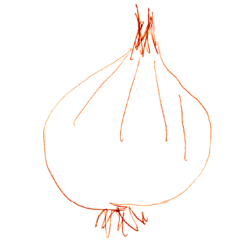
The couple’s natural leaning towards “biological, zero-kilometre living wherever possible” and artistic exploration combined with modest, anti-crisis prices (a two-course menu is only €7,50) soon attracted a dedicated following. While a weekly lunch is the main dish, Espai nyamnyam(“yumyum Space”) has evolved into a multidisciplinary cultural association, reflecting Ariadna’s diverse creative background in dance, visual arts and classical violin. “Over the last several years, our separate interests have merged. I call it ‘nuevas dramaturgias’. Bringing it all together is a natural progression of our creative world, and Nyamnyam grows organically according to the synergies that surround us – we don’t have a plan,” she tells me while preparing a Roobois tea. “It goes with Iñaki’s philosophy of ‘first do, then think’!”
Participants and artists perpetuate the project through month-long residencies, childrens’ workshops and theatrical performances, as well as an occasional printed fanzine. Ariadna and Iñaki source produce from Aurora del camp less than 20km away, reflecting the couple’s enthusiasm for sustainability and local networking.
Ariadna Rodriguez while serving food and interacting with the guests. Everything feels very casual and like a bunch of friends getting together
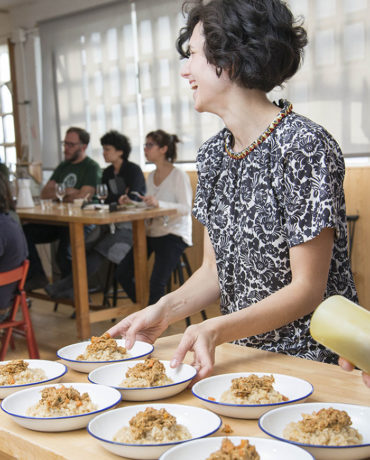
It’s Wednesday and the kitchen island is marooned in a forest of over 80kg of beans, brassicas and blushing beetroot. A steady stream of neighbors and socios arrive to collect their vegetable boxes and tomorrow Iñaki will cook nyamnyam’s weekly lunch with whatever is left. “One week they had harvested an abundance of basil, so we made several recipes – pesto, green risotto and calamares with pesto mayo - created a booklet and called it ‘Green day’. Someone took the photographs, another person wrote the text, and a friend printed it.”
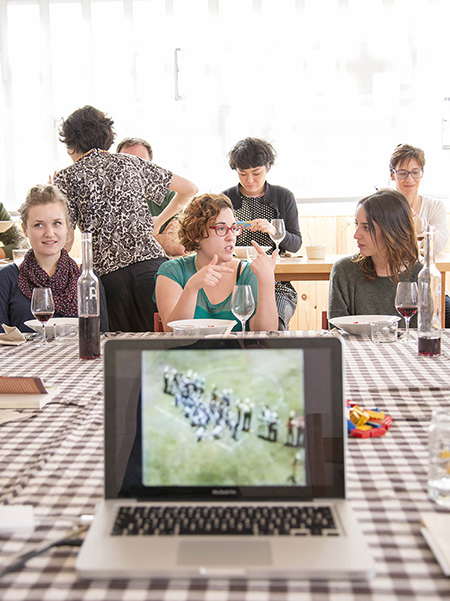
The audience of nyamnyam is very diverse and most people don't know each other. It could be that a French sits in between a woman from Argentina and a man from Croatia. Ariadna tells us that the food is just an excuse for bringing people together.
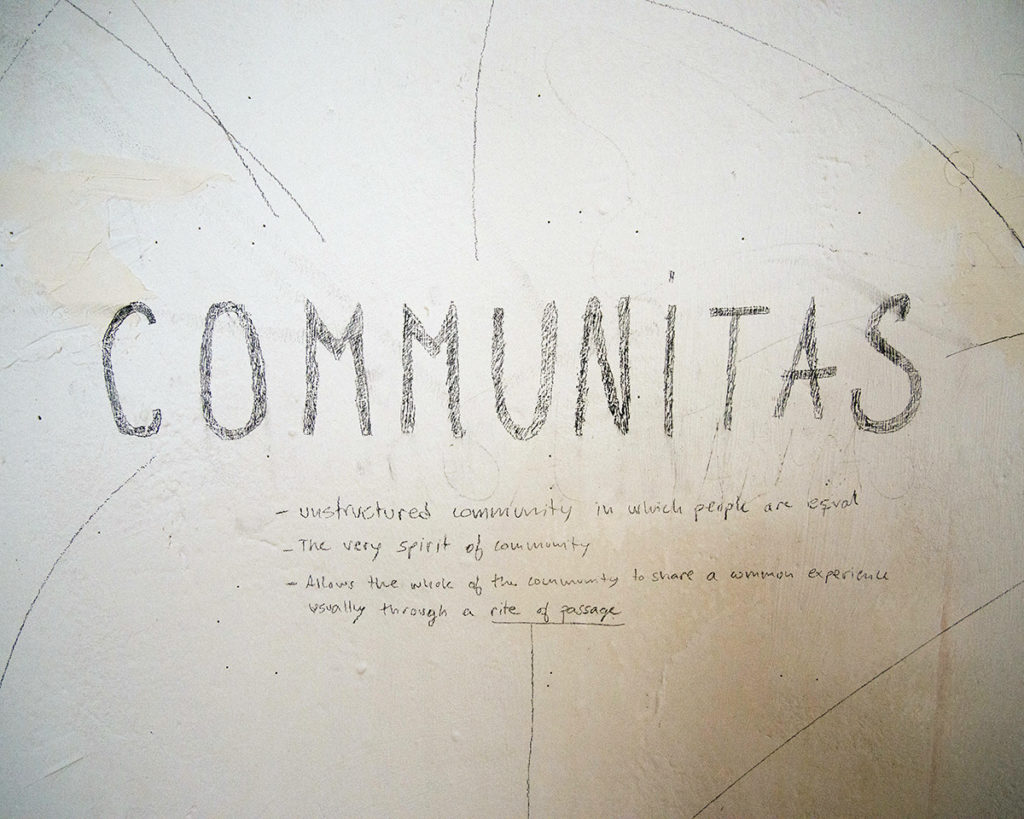
Each month, the resident artist chooses how to structure nyamnyam’s leitmotif, “Todo lo que me gusta es …., …. o engorda.” ("Everything I like is …., …. or is fattening"). When I visit, Job Ramos is in the second week of his stay. “From the first meal, people were hoping for some sort of performance or video, but I wanted to see if we could control the dynamics at the table. Diners have become the subjects and most of them don’t know it. Last week, two girls sat next to each other, so this week we made sure two different girls sat in the same place. Other times, things recur that we don’t expect. Is it possible to control and repeat social situations? We’ll layer coincidences each week until the experiment reaches its natural conclusion.”
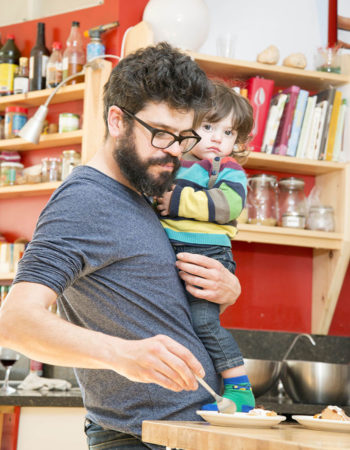

Iñaki and offspring tasting their delicious homemade dessert.
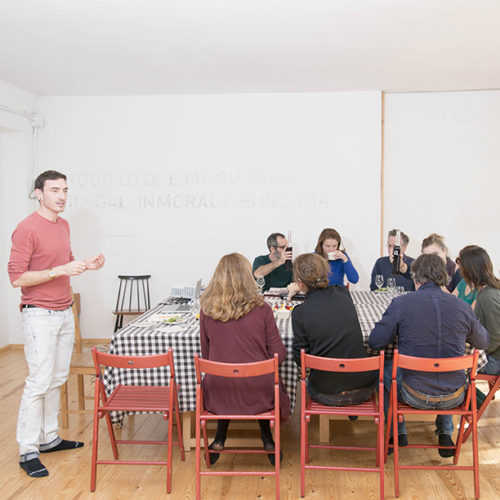
Aimar Pérez Gali is this week's artist in residence at NyamNyam, exploring the concept of "Micro Comunitites". He works in the fields of dance and performing arts and he is a member of the jury of the Miquel Casablancas' Visual Arts Prize and director of the Espacio Practico, a self instituted space in the center of Barcelona.
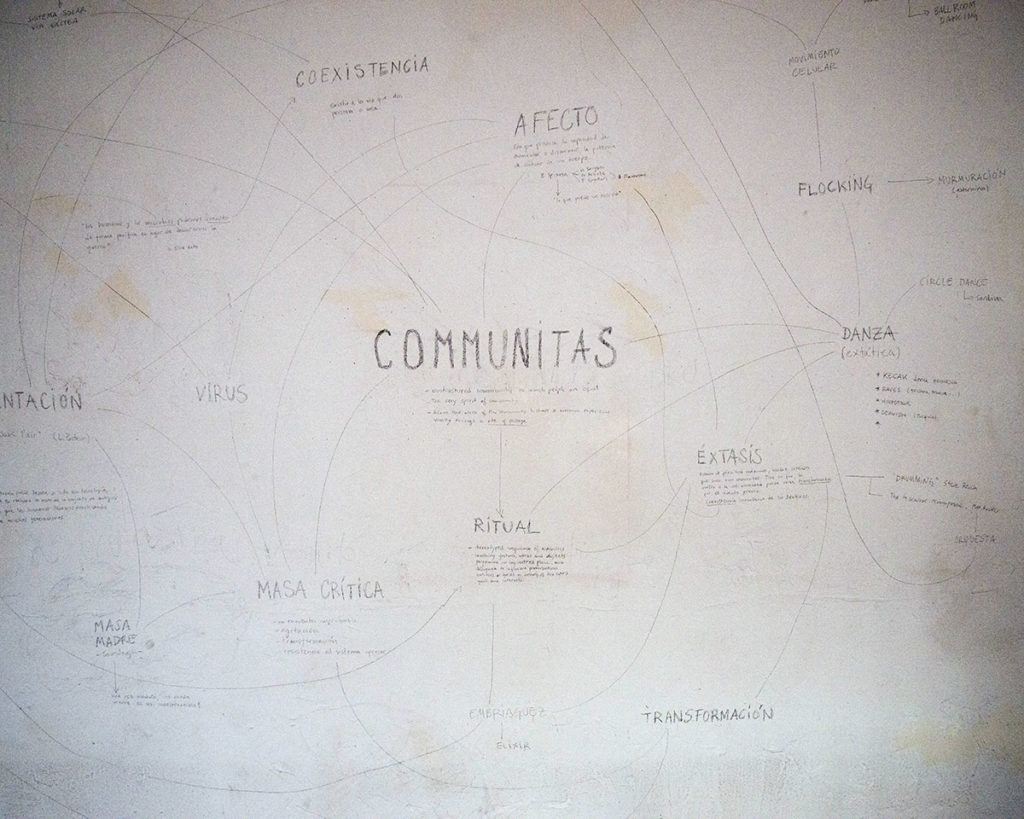
Another artist, Aimar Pérez Galí, explored micro and macro scales through the phenomena of fermentation and its associated organisms, later repackaging the idea into a cosmic-themed workshop for kids. One might imagine that these theoretical ideas would be complex for children to grasp, but Aimar transported them into a world where rice, fish and algae became stars, planets and satellites of the solar system, creating their own sushi and then eating it. “It’s a wonderful way to get kids involved with food,” says Ariadna as she feeds her daughter a plump green bean.
«THE ECONOMIC CRISIS IS A TREMENDOUS OPPORTUNITY FOR REINVENTION. NOW, LOTS OF PEOPLE START THEIR OWN PROJECTS, IT'S LIKE A WHITE PAGE. AND MAYBE ITS ALSO A TIME FOR REFLECTION, TO SPEND MORE TIME WITH YOUR FAMILY OR TO HAVE BABIES.»
ARIADNA
But why Poble Nou as opposed to, say, the northern Gracia district, where ecological fare and healthy living are already a standard part of the community’s fabric?
“Actually, it’s a great place to bring up children here, too,” she smiles.“You get a lot more space for your money here. And of course there are economical matters to consider.” Simply put, it’s cheaper. “It comes back to the idea of comunitas. There are no rules in Poble Nou yet – we’re creating our own opportunities and communities here. People come into this space and food is a democratizing element, a conversation starter. We’ve created the structure through nyamnyam, but it’s the people that give it content.”
While other parts of Spain continue to suffer the brunt of financial instability, gastronomic explorers Ariadna and Iñaki are the stars of their own entrepreneurial imagination. nyamnyam feeds the urge to connect with others while maintaining creative dialogue in the face of rapidly dissolving opportunity.
Every good cook needs to taste before it gets served.

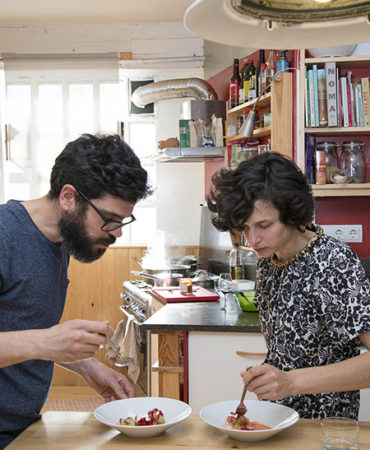
CULTURE ON WHEELS
Photography Stefan Jermann
Kevin is a former Inline Skate Pro, now he uses Poble Nou and the stunning spaces of the Forum to practice new tricks.
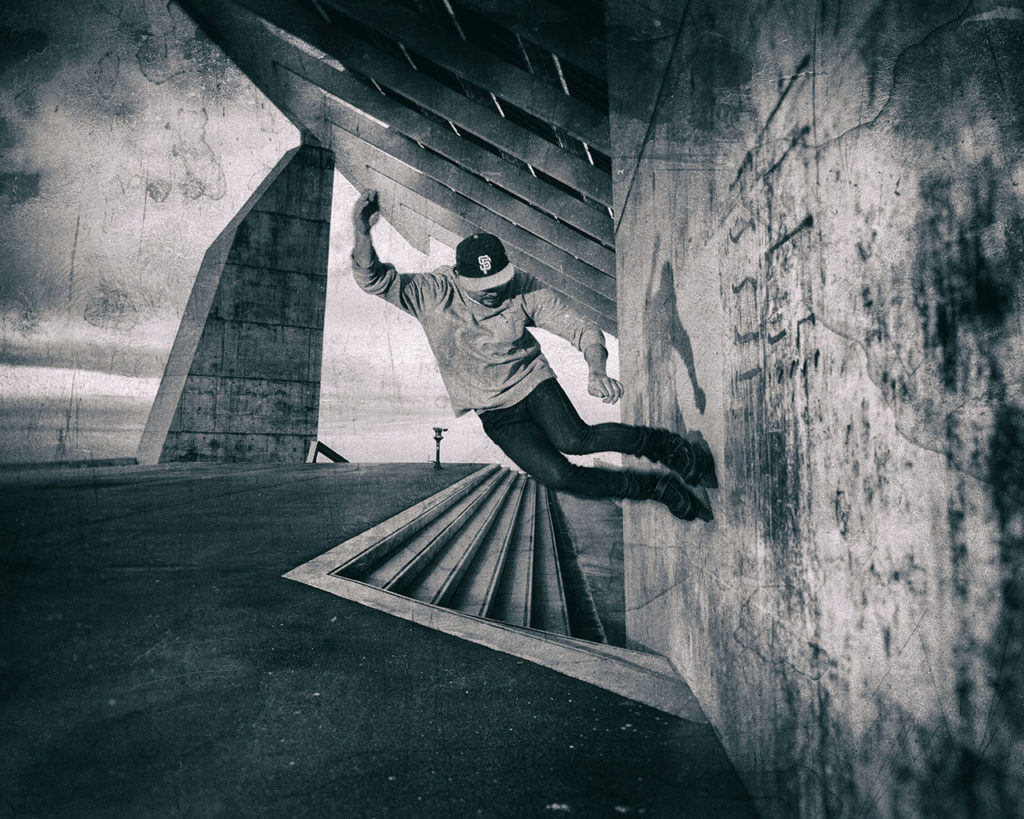
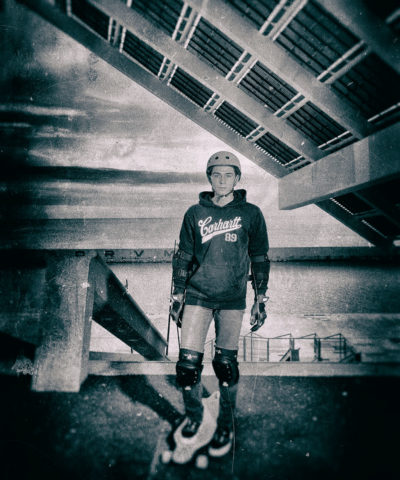
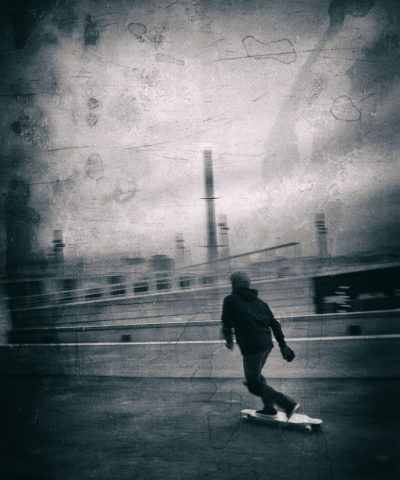
Longboarders at the Forum during their practice.
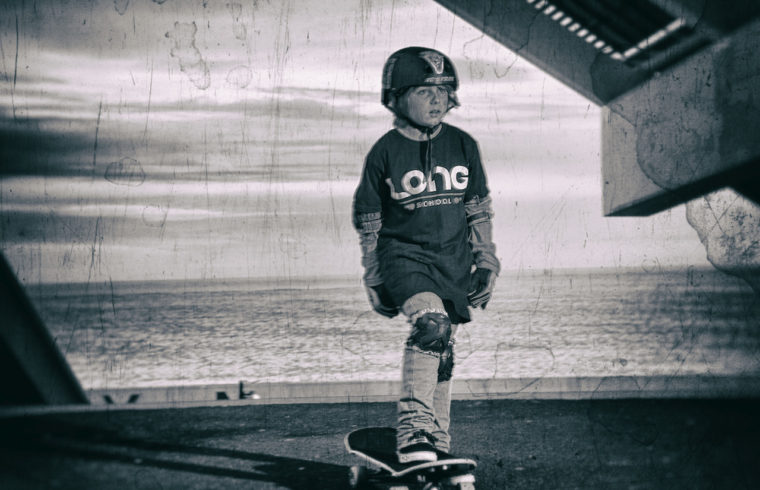
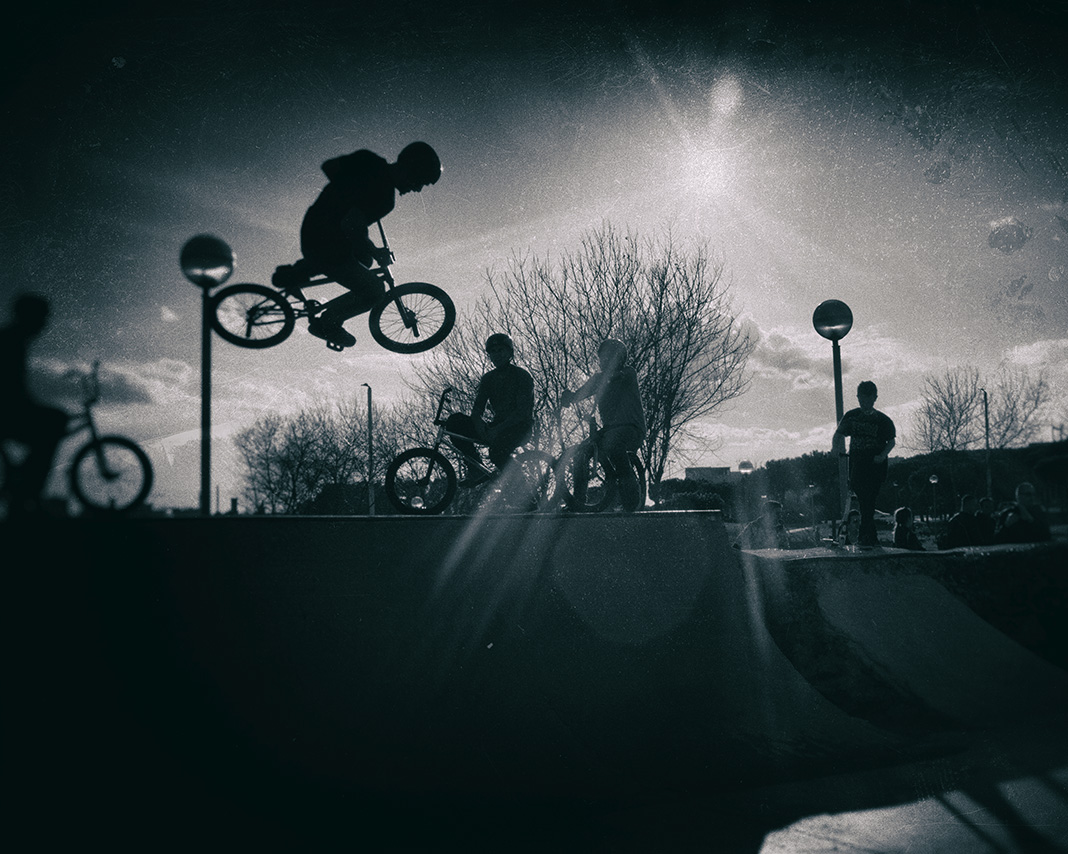
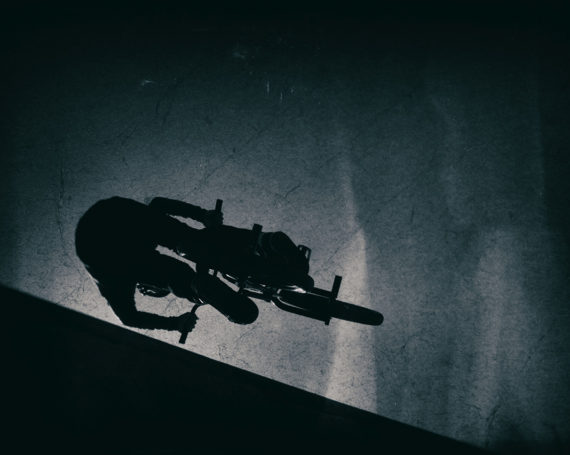
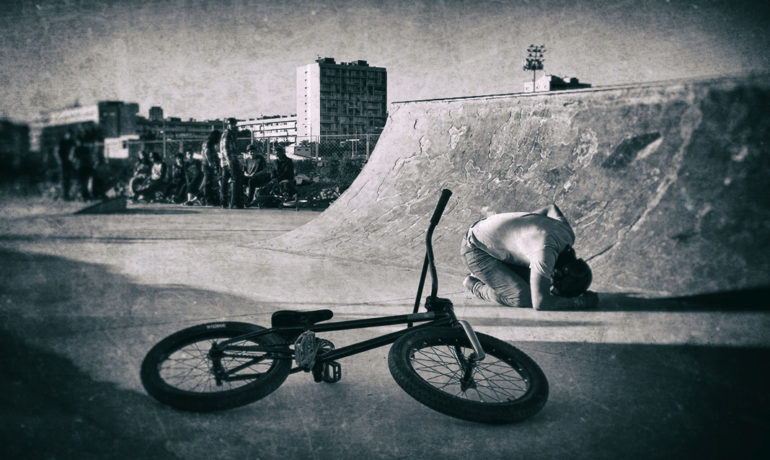
GORI DE PALMA
ICON of PROVOCATION
A tale about subculture, sex and motorcycles
Photography Stefan Jermann
FASHION ADDICT,
MOTORCYCLE REBEL
AND DJ
MALLORCAN-BORN GORI DE PALMA HAS BEEN DESIGNING CLOTHES FROM HIS CLANDESTINE POBLE NOU STUDIO AND HOME SINCE 2010. HE’S GARNERED A CULT FOLLOWING AS FASHION DESIGNER AND DJ, REGULARLY GRACING THE CATWALK AT MADRID FASHION WEEK AND INVITED TO HOST HIP PARTIES AROUND SPAIN. BUT RATHER THAN MINGLE IN THESE CIRCLES, GORI IS MUCH MORE AT HOME ON POBLE NOU’S HEAVY-METAL BAR CIRCUIT, IN HIS WORKSHOP REWORKING VINTAGE JACKETS, OR RESTORING OLD MOTORCYCLES, ANOTHER OF HIS GREAT PASSIONS.
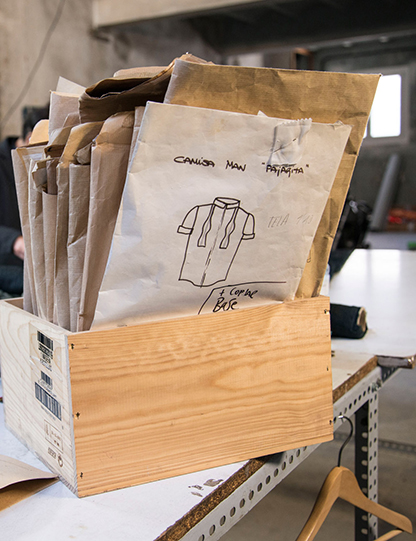
Gori's Atelier is located in a former garage.
His two assistants are preparing for Madrid fashion week.
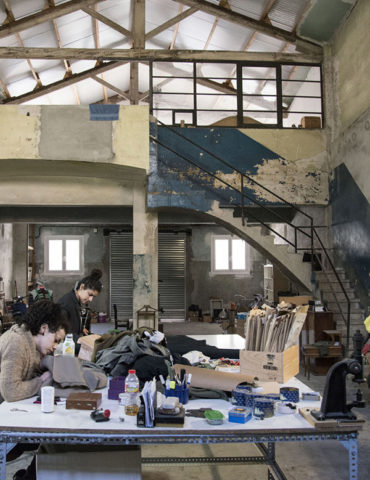
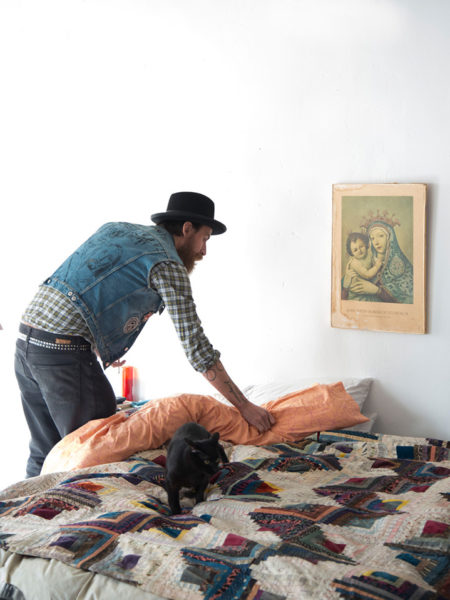
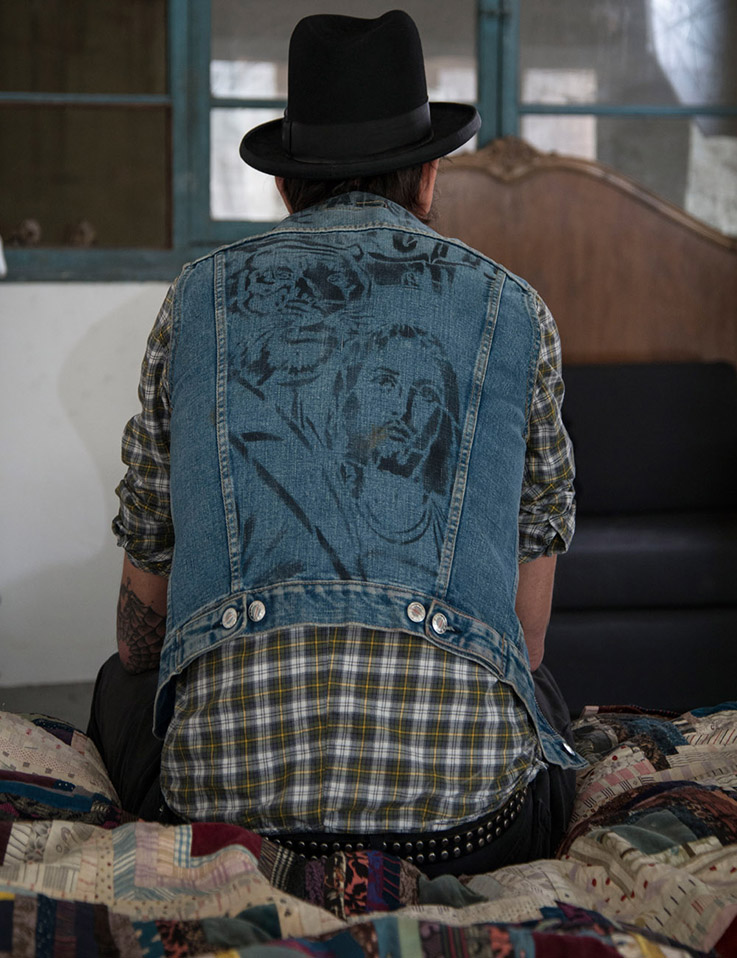

Gori is a craftsman and his passion
besides fashion is to restore street bikes.
«I'M INSPIRED BY VALUES THAT TRANSCEND AESTHETICS.»
When I arrive at Gori’s studio, he’s deep in preparation for Madrid fashion week. One assistant pins khaki fabric to mannequins while another shuffles camouflage print and afghan scarves around the cutting table. A pile of de-constructed 1930s military jackets awaits resurrection in the corner. Gori observes them at work, occasionally tweaking between soft-spoken but firm instruction.
His latest collection, The origin of evil, is all muddy khaki, greys and afghan check, observing “how certain groups of people have created a movement to fight for their democratic freedoms, for economic and socio-political changes in the Arab Spring,” he says. “I see it as a new subculture in itself. Aside from the aesthetic, I was interested in the revolutionary subject, the struggle to change things.”
And isn’t that what subcultures do? They disrupt culture in waves of innovation until the underdog is eventually absorbed into mainstream culture. Gori’s work evokes this disorder of human experience, and his inimitable style has even earned him a Jack Daniels sponsorship, the ultimate rock’n’roll badge of honor. It’s these whisky-drenched nights with kindred spirits that fuel his work.
“When I go to rock bars here in Poble Nou, it’s the skinheads, bikers, punks and aesthetic movements associated with music that move me – new wave, punk, post-punks…” Gori tells me, somewhat dreamily, from his private atelier above the studio. “I’m inspired by values that transcend aesthetics.”
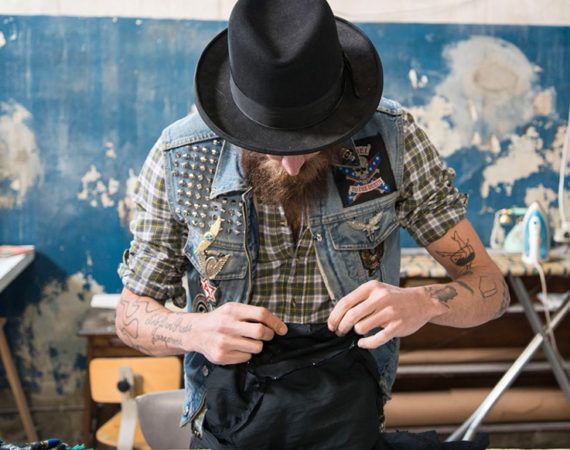
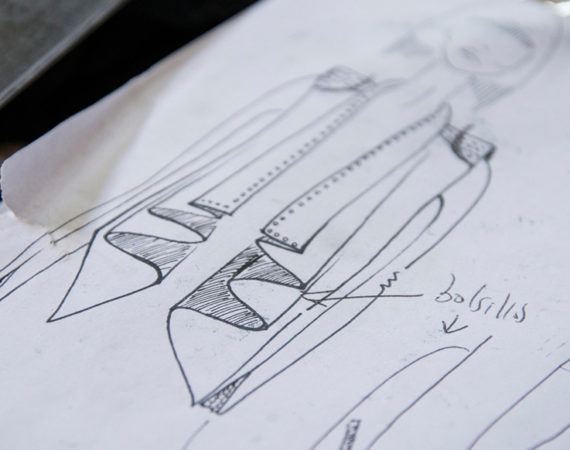
One of Gori's favourite male models, wearing a jacket from the current collection.
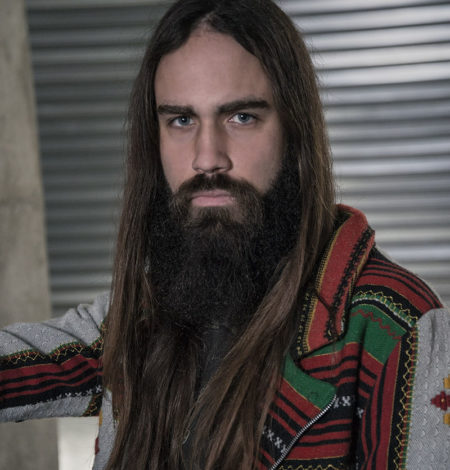
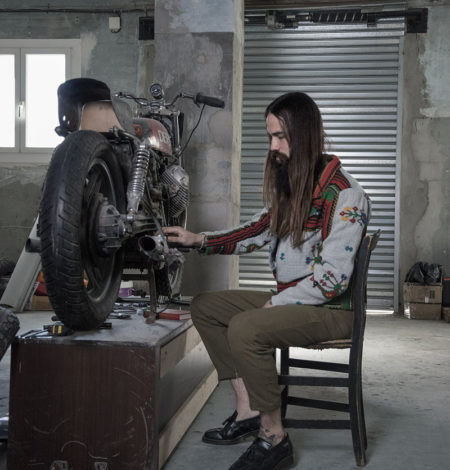
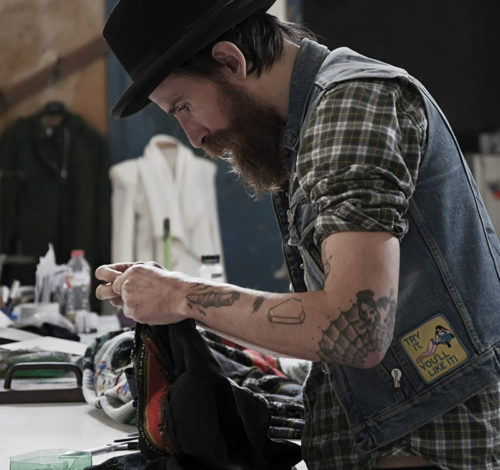
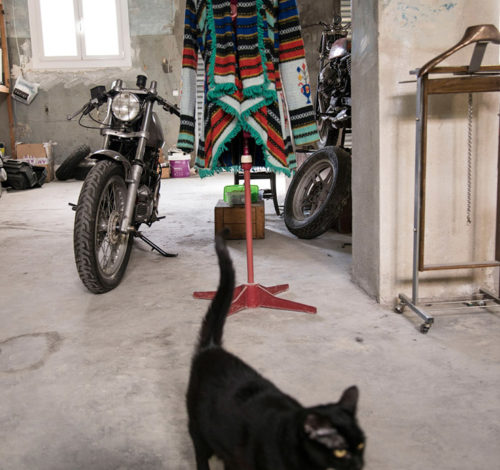
«I'M NOT AGAINST LARGE-SCALE PRODUCTION AND THE IDEAS BEHIND IT ARE GREAT, BUT I FIND IT VERY IMPERSONAL AND LACKING IN STYLE.»
I glance at an almost empty bottle of whiskey on the floor, then at his boots, thick with dried splashes of devil’s liquor and dust. I wonder, beyond the odd smattering of motorbike grease, if they’ve ever been polished. He’s perched on a patchwork quilt that barely covers a sheet-less duvet. A faded painting of the Virgin Mary watches over us. Gori’s delicate, almost bird-like features are quite striking when combined with the pious minimalism of his bedroom, but his tattoos and thick, flame-red beard fortify his appearance.
Gori is drawn to brooding greys and blacks – obsidian, charcoal, onyx, raven and soot are the shades of hard graft. Gori’s collections of threadbare t-shirts and scuffed denim resemble workers’ clothes, echoing the crumbling bricks and mortar that surround him. It’s as if he can’t help but absorb the neighborhood’s industrial landscape through osmosis.
He also creates womenswear to channel other aspects of his creative vision. In a previous collection, he used crochet tablecloths and the frothy lace of antique undergarments to evoke these ethereal qualities. The use of vintage textiles means Gori’s pieces are safe from mass production and he often creates one-off pieces for individual clients using clothes that are historical artifacts in their own right. Some of these revived vintage pieces could have been produced in one of the factories right here over a century ago. But, ironically, you won’t find Gori’s label on a factory line anytime soon. “I’m not against large-scale production and the ideas behind it are great, but I find it very impersonal and lacking in style” he says.
This year Gori will uproot the studio after over five years in the neighborhood. Despite the attractive working environment and cost of living, a bigger workshop further afield has lured him away. “I’m creating a new label that will tie in with a motorbike restoration workshop. The two things I like most in this world – fashion and old motorbikes.”
Gori De Palma’s clothes talk of a subversive decadence that is entirely his own creation. He goes beyond the usual superficiality of fashion with a fiercely individualistic approach that encompasses an entire philosophy of living. “Freedom of expression is my biggest motivation to create.”
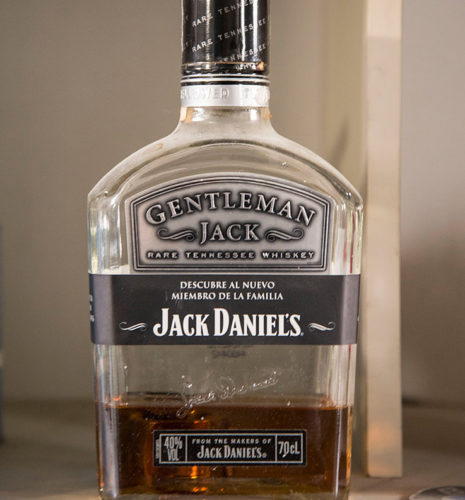
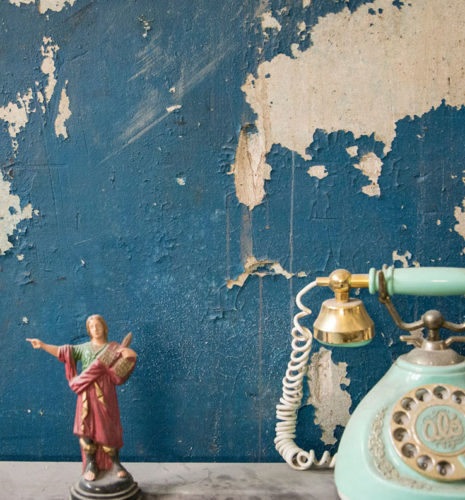
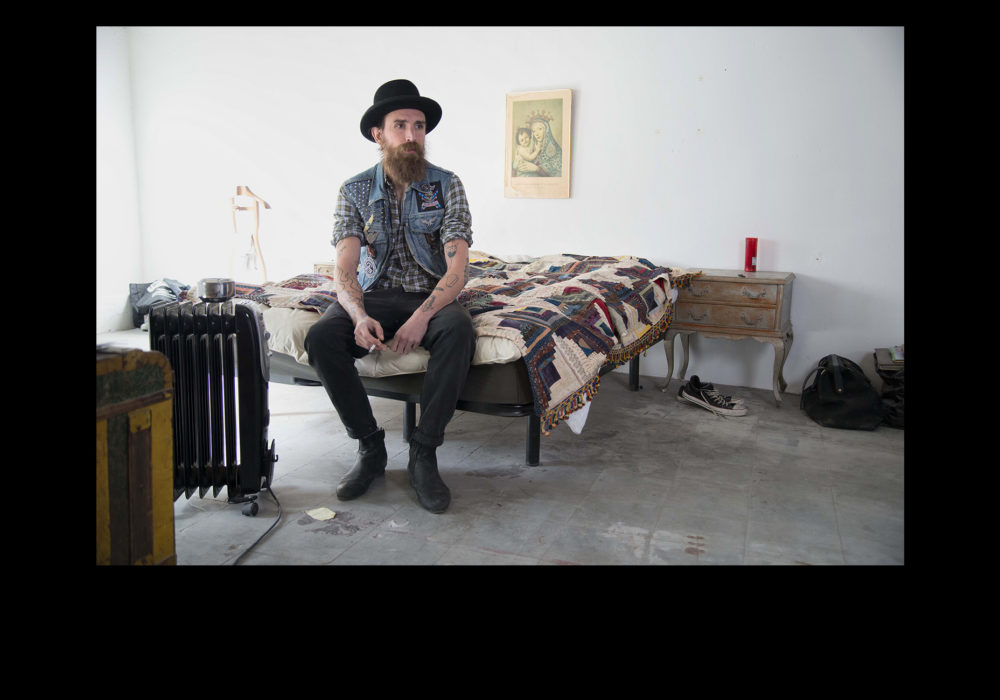
How to re-write the rules of female erotica in a male dominated business. Meet Erika Lust: enterpreneur, mother and visionary filmmaker.
INTERVIEW NATASHA DREWNICKI
PHOTOGRAPHY STEFAN JERMANN
THIS WOMAN STORMS EROTIC FILMMAKING
SINCE STORMING INTO ADULT CINEMA IN 2008, ERIKA HAS FLIPPED MALE DOMINATED PORN ON ITS HEAD. AS A CREATOR, SHE USES THE ADULT GENRE TO MAKE FILMS THAT EXHILARATE THE SENSES AND THE MIND. BUT MOST IMPORTANTLY, AS A FEMINIST, SHE CHALLENGES THE INDUSTRY’S PRECONCEPTIONS OF SEX AND RELATIONSHIPS AND INVITES WOMEN TO EXPLORE THE DEPTHS OF THEIR OWN SEXUALITY.
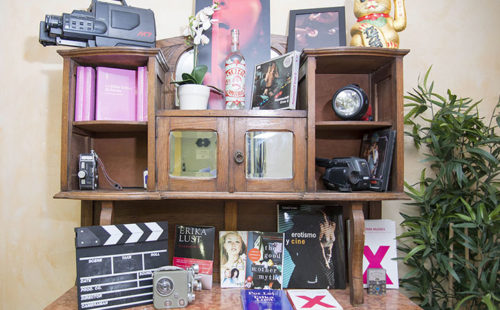
In 2008, Erika Lust began her first forays into cinema with her debut movie, The Good Girl. In this twenty-minute short, a young woman seduces the pizza delivery boy through an unexpected twist of events, thus liberating herself from her own fears of sexual freedom. The Good Girl received over two million online views within the first week of its online release and garnered several prestigious awards, heralding Erika’s arrival as talented adult-film maker.
Erika’s refreshing departure from the traditional porn mold sent ripples of excitement and admiration throughout the industry. But she also became the target of venomous hate mail from traditional porn subscribers, who went as far as to label her a “femi-nazi.” Why was the character in The Good Girl such a threat to porn? What was so controversial about an empowered woman enjoying sex on her own terms?
One bright spring morning, I go to interview Erika at her headquarters. A cheerful and attractive Swedish woman greets me with a kiss on both cheeks, shows me to her office and lights a scented candle, then disappears for a few moments to take care of some important business before we begin.
Tucked away on the sixth floor of a converted factory, the creative freedom of Poble Nou is exactly what inspired her to set up an office here in 2009. “Erika Lust was born in Poble Nou!” she later tells me.
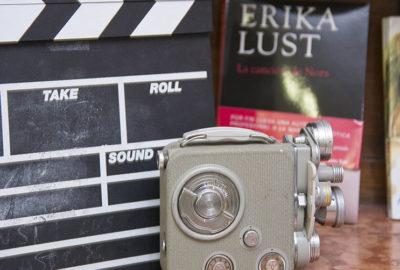
Like Erika herself, the office is small but neat; one wall is lined with erotic literature and a storeroom houses all sorts of artfully designed merchandise, DVDs, toys and playthings. I read her statement of intent, in large, bold type on the wall behind the desk:
"I pledge to create new waves in adult cinema, to show all of the passion, intimacy, love and lust in sex: where the feminine viewpoint is vital, the aesthetic a pleasure to all of the senses, and those seeking an alternative to porn can find a home.”
I’m keen to understand what drives Erika to make these movies in such a macho realm. In another interview she said that, excluding actresses and make-up artists, only 2% of the adult-entertainment industry is female.
I’d already seen a few of her films prior to meeting (whoever says research is boring doesn’t get to interview Erika Lust!) and – compared to mainstream porn, with its strip lighting and constricted gaze on faceless body parts – these are an invigorating slap on the bottom to watch. You meet real women who feel ridiculous wearing uncomfortable heels to a date, with folds of flesh, cellulite and gaps in conversation, the butterflies of a first encounter and the taste of a second kiss. Relationships unfurl on screen before it gets to the good bit… but actually, that is the good bit. Erika returns to her desk, bright-eyed and eager to begin. I can sense she isn’t one to mince her words, so we get straight to the interview.
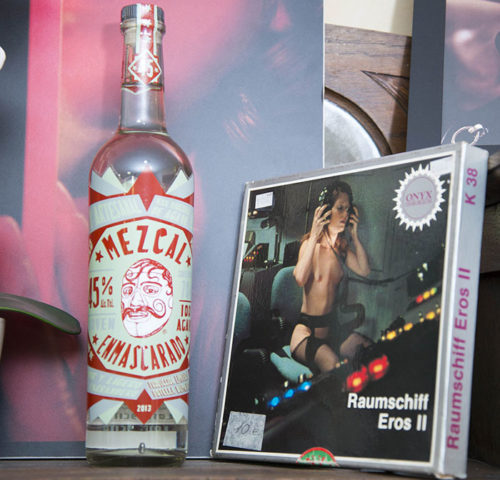
Erika has directed numerous erotic beststelling movies and written numerous books on the topic of female porn that are sold throughout the world.
«I KNEW THERE HAD TO BE ANOTHER WAY OF EXPLORING SEXUAL EXPERIENCES IN A WAY THAT I FOUND ENJOYABLE AND THAT WAS ENJOYABLE FOR WOMEN.»
Erika Lust
WHAT DRIVES YOU TO CREATE ADULT FILMS?
When I first saw a porn movie with my boyfriend back in Sweden, it seemed so cold and robotic and it didn’t feel or look like real sexual relations between two human beings at all. It made me uncomfortable. I was always very aware, through my studies, that sexuality is deeply connected to our happiness. Something didn’t feel right about porn. I began to question it. Porn is supposed to be a genre you can enjoy and relax with, but the traditional aesthetic seemed anti-erotic to me and very far from my own values. It was hard to watch without feeling disgusted by it.
As a creator, I’m turned on beautiful imagery. When we look at art, we look for values that resonate with our own, but in mainstream adult cinema you only see the values of middle-aged men: their ideas, their sexism, homophobia and aggression. I knew there had to be another way of exploring sexual experiences in a way that I found enjoyable and that was enjoyable for women.
HOW DID YOU GET INTO THE ADULT FILM INDUSTRY?
I graduated from Lund University in Sweden with a degree in Political Science, specializing in Gender studies and Feminism. I originally intended to work for an NGO. After graduating, I came to Barcelona with a Spanish scholarship and then began working as a production assistant in the advertising industry. I fell in love with film because there’s so much opportunity to tell complex and layered stories through this medium, so I started a night course to learn the technicalities of it. Women’s rights are something I’ve always felt strongly about and film seemed like the natural medium to explore this. My work is still political – as a feminist, I’m showing my vision of relationships between men and women.
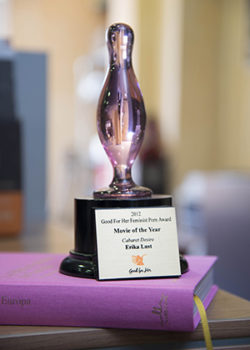
HOW DO YOU CREATE YOUR WORK?
The creative process is extremely time-consuming. I sit in front of the computer for very long periods while writing. It’s relaxing to write uninterrupted because there are no limitations. It’s liberating. I began our latest project, XConfessions, because so many people had emailed their own candid fantasies and sexual confessions. They were looking for someone to listen to their ideas, to hear their voice. It feels great to know that people can identify with the films I make and want to share their own experiences with me. The letters I received were so revealing that I just had to sit down and create a script for them, which is howXConfessions was born.
WHAT KIND OF RESISTANCE HAVE YOU FACED?
When I first started, I had never worked in the adult industry before. It’s very frustrating to communicate a message that is new and different. I still can’t use Paypal, I have problems with banks. Facebook recently closed my account when I posted “Mi coño, mis normas” ("my vagina, my rules"), about pro-life choices. A lot of individuals – members of an anti-abortion group – flagged it as inappropriate because they said it was“promoting self-harm.” How ridiculous! It’s my fight – I must move around these limits and adapt to these hurdles, but it is very frustrating. There are still so many preconceptions and prejudices to navigate. It will take time.
«I AM A FEMINIST FILMMAKER WHO WANTS TO SHOW ALL OF THE BEAUTY, FUN, PASSION AND INTIMACY OF SEX. I WANT TO EXCITE BOTH PEOPLE’S MINDS AND BODIES: BUT ONLY MY OWN, WHICH HOPEFULLY ADDS MORE TO THE INDUSTRY.»
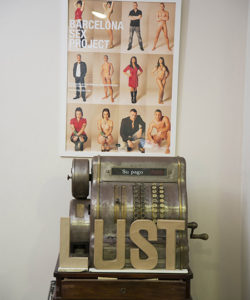
WHAT’S SURPRISED YOU MOST ABOUT THE INDUSTRY?
I’ve spoken to a lot of actors and actresses who’ve had many negative experiences. Some of them arrive on set and don’t know who they’ll even be shooting with, others do their own makeup and provide all of the props. Others aren’t paid fairly. There is a lot of exploitation in this industry. So when I shoot films, we have a make-up artist, we try to create a warm and inviting, comfortable atmosphere. I ask the actors if they know someone they’d be comfortable working with. It’s a collaborative effort.
WHAT WOULD YOU LIKE PEOPLE TO LEARN FROM YOUR FILMS?
Pornography is a topic that cannot not be discussed. There’s a great urgency and opportunity to enjoy adult cinema without feeling disgusted by sex. Adult cinema can be a wonderful way to learn about sexuality. Young people have very easy access to porn today, even before they begin to have sexual experiences. I want them to understand how relationships really are between men and women. It’s not just about pleasing your boyfriend or about being a “porn-star” in the bedroom. We urgently need to get that message through to the younger generation.
«PORNOGRAPHY IS A TOPIC THAT CANNOT NOT BE DISCUSSED. THERE’S A GREAT URGENCY AND OPPORTUNITY TO ENJOY ADULT CINEMA WITHOUT FEELING DISGUSTED BY SEX.»
«WE SHOULD ALL FEEL MORE CONFIDENT IN OURSELVES. IN OUR ABILITIES TO ASK, AND GET WHAT WE WANT, NOTJUST IN SEX, BUT IN LIFE TOO.»
ERIKA LUST

DO ALL WOMEN HAVE THEIR OWN ERIKA LUST?
I am Erika Lust when I am creating. She is daring and bold, she pushes me to do things and she gives me the confidence I don’t always have as Erika Hallqvist. Thanks to Erika Lust I have a profession I love and a business that is growing by almost 40% every year. We should all feel more confident in ourselves – in our abilities to ask, and get – what we want, not just in sex, but in life too.
Swedish-born Erika Hallqvist is a thirty-four year old award-winning film director and entrepreneur, feminist, writer, wife and mother of two children, aged three and five. Most famously known as Erika Lust, she is the co-founder of Lust Films with her husband, Pablo Dobner.
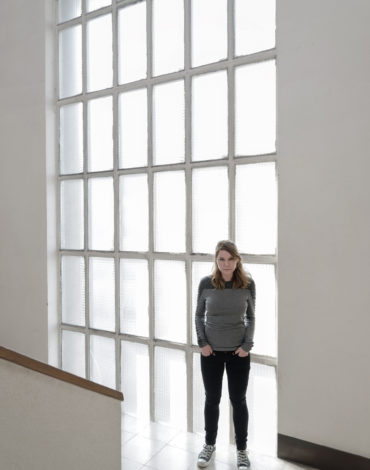
La Escocesa
LABORATORY OF RESISTANCE SPARKS ANEW
POBLE NOU_
"JA NO ÉS XAUXA!"
Photography Stefan Jermann
Text Tasha Nicky
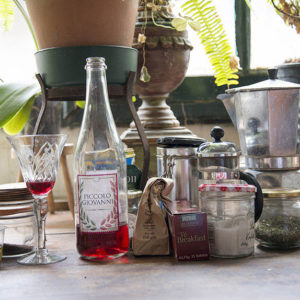
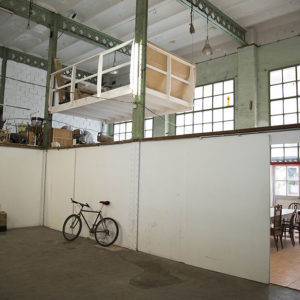
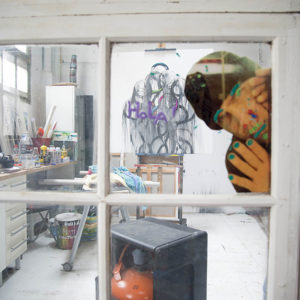
A FEW STREETS FROM THE TORRE AGBAR AND MEDIA-TIC BUILDING, GLIMMERING BEACONS OF POBLE NOU’S 22@ PROJECT, THERE IS A LITTLE-KNOWN VACÍO OF SPACE THAT APPEARS LOCKED IN STASIS. WIRE FENCES SLICE THROUGH SQUARES OF LAND INHABITED BY SOLEMN FACTORY CARCASSES AND TALL GRASS. NATURE IS RECLAIMING THE TERRITORY ONCE DESTINED FOR LUXURY APARTMENTS.
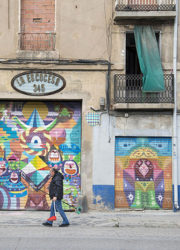
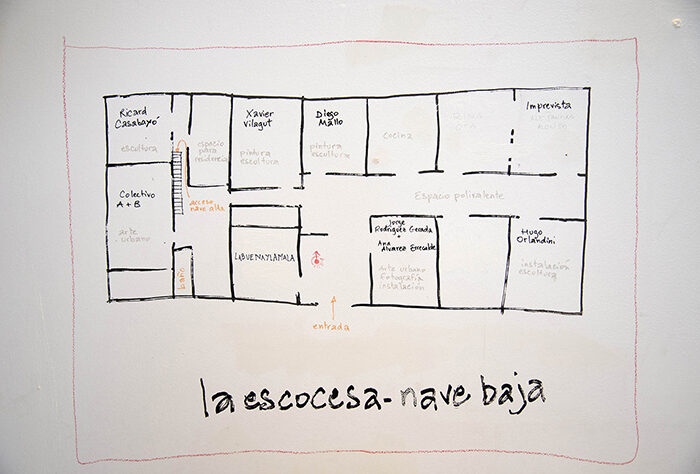
A floor plan shows the studio spaces of La Escocesa and on the rooftop you have a great 360 view overlooking Poble Nou.
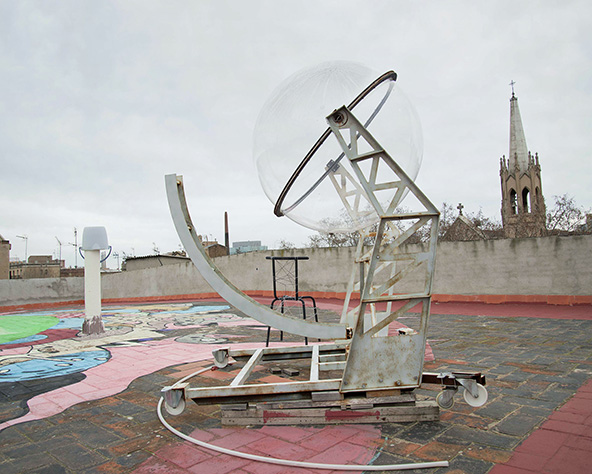
I stand on the pavement of a crumbling boulevard, opposite an old church. It strikes half past the hour. Somewhere in the distance, a dog barks. Above the iron door, an antique sign spells La Escocesa. I knock and wait for almost ten minutes before hearing the clink of keys. The door opens to a bearded man in overalls. “Have you been waiting long? It takes a while to get here – I was on the other side of the building!”
Meet Juan Francisco Segura, one of the longest standing artists at La Escocesa, a sprawling 2400m² factory complex and one of the last surviving naves in Poble Nou. La Escocesa originally produced chemicals for the textiles industry and today it most emblematically represents Poble Nou’s turbulent journey from abandoned industrial zone to international creation hub, alongside other notable factories such as Can Ricart (now Hangar) and Can Felipa(since transformed into a cultural centre).
Juan Francisco guides me through a graffitied arch and into a mint-green studio with spectacularly high ceilings. In contrast to the drowsy scene outside, studios are abuzz with productivity, the air thick with turpentine and aerosols. A woman crouches to spray Perspex acid blue while others chatter in the communal kitchen at the back. We continue through a warren of stairs and studios until we reach his space, an inviting and lived-in area that bears the familiar hallmarks of an artist’s life. Rothko-esque oil paintings pile high on a shelf and paint pots scatter across a central table where we sit down as if at an office desk.
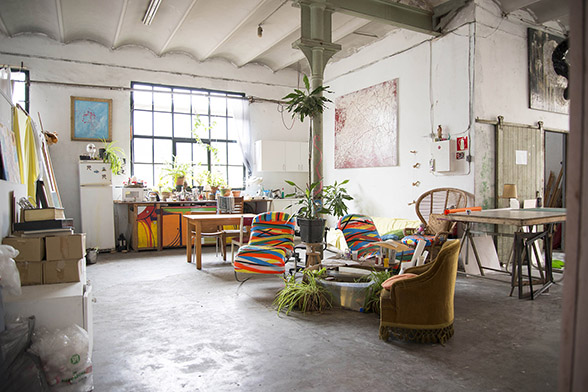
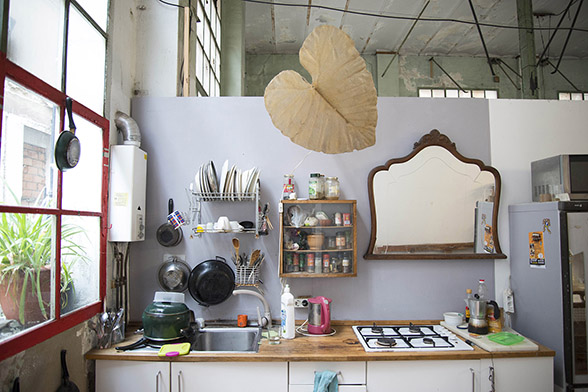
La Escocesa feels a bit like one large family. Here, people cook, eat and socialize together. There is no competition between the artists, instead they support each other.
«We made the building safe. We excavated entire sacks of material, chemicals, dead rats, crochet…we put everything into this place.»
JUAN FRANCISCO
In 1999, Juan Francisco was part of the original community who rentedLa Escocesa from a distant relative of the original industrialist owner. Since shutting down operations in the eighties, it had become a dilapidated time capsule, the intrepid group of artists set about transforming it. “We made the building safe. We excavated entire sacks of material, chemicals, dead rats, crochet…we put everything into this place,” he tells me.
Driven by the success of the Olympics in 2000, the government spearheaded a $180million 22@ District of Innovation program. Through economic and social initiatives, Poble Nou would become “a new space of urban innovation that will comprise businesses, institutions, universities and technology centers”, then Barcelona Mayor, Xavier Trias, told La Vanguardia newspaper.
Almost overnight it sprinted from dormant working-class neighbourhood to the site of prime real estate potential. With floor space at a premium elsewhere in Barcelona, the abandoned, open-plan factory compounds were available at rock-bottom market prices, making them an attractive investment that would pay dividends tenfold. In the words of 22@, the area would“represent a living lab”, a catalyst to attract highly specialist, skilled workers and transform Poble Nou into a digitized, private zone for an altogether new type of industry.
«Houses such as Hangar and Escocesa are the district’s emblems. It’s a huge paradox that Catalan industrial patrimony was left in ruins.»
Josep María Montaner, Architect
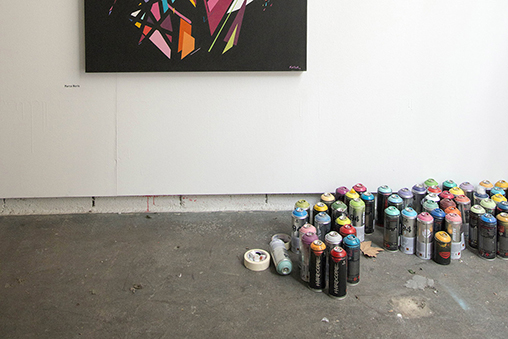
Poble Nou’s self-sustaining art industry clearly didn’t fit 22@’s criteria of profitability and artists were among the first to feel the pressure of encroaching developers. A private company, Renta Corporación, lured the owner into selling La Escocesa for a healthy sum, with the intention of razing it to the ground and replacing it with luxury apartments. Overnight, they threatened eviction.
“I don’t think they understood - or cared - that we were serious, self-organized workers who needed a space to create that simply didn’t exist elsewhere. The developers treated us like squatters,” explains Juan Francisco. “It might as well have been the Wild West - they made the rules up as they went along. They just wanted offices, hotels and expensive apartments, and to leave one factory chimney.” 22@ was - on the surface at least - an initiative to promote and defend innovation and culture, yet here was a flourishing grassroots association in a building of national patrimony that was about to be trampled.
Juan's art is not only displayed on canvas. Right now he puts little paintings in acrylic boxes and they now look like precious relicts.
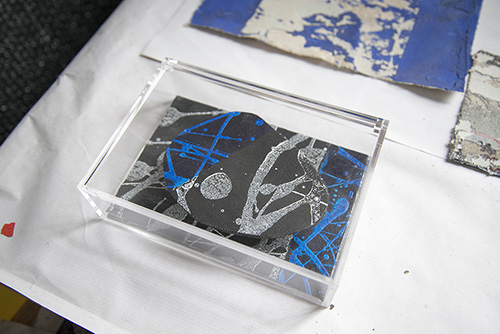
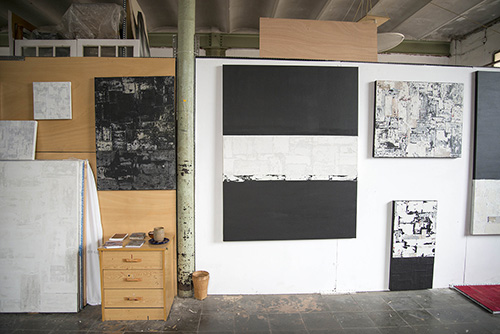
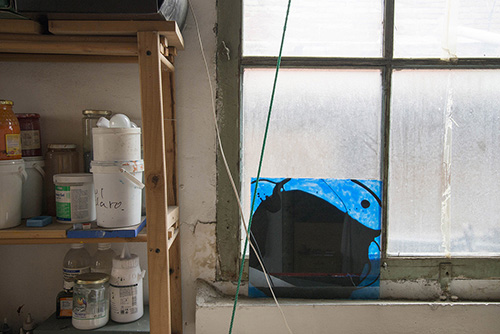
Not surprisingly, the tug of war descended into a physical lucha. The heavy-handed approach of speculators ignited furious debate that reverberated across the city and violent protests echoed the discontent. Building a space by demolishing its existing heritage was a mistaken approach to urban planning, argued locals. When artists demanded an explanation, Renta Corporación barricaded La Escocesa’s factory doors and even removed a staircase, forcing them to saw a hole in the floorboards and scramble up to first floor studios. In the face of danger (and a potential PR nightmare), the council intervened.
In agreement to tick the right boxes for the sake of official administration La Escocesa founded theEMA Ideas Association, a platform to link the community’s professional interests with those of the council. In 2006, amid mounting pressure, the council implemented The 'Factories for Artistic Creation' program and recognized La Escocesa as a site of local interest, safeguarding it against demolition along with 113 others in the area. And in a bizarre twist of fate, 2008’s economic crash was soon to send hundreds of real-estate companies spiralling into bankruptcy, owing to the frozen scene outside.
Aside from a small handful of original residents, today most of the 20 artists that work at La Escocesa are invited by open call, judged externally by industry pros based on previous work. Javier Mariscal, design star of the Barcelona Olympics and one of the founders of the Palo Alto studios nearby, has overseen the process on several occasions. La Escocesa participates in the bi-annual Tallers Oberts(Open Workshops) initiative that encourages collaboration and networking between workshops across the district, promoted by the Poblenou Urban District map. The complex also holds its own events, such as the wildly successful mural festival last September, when artists were invited to breathe new life into the crumbling factory walls, resulting in a series of vast painted murals, pictured.

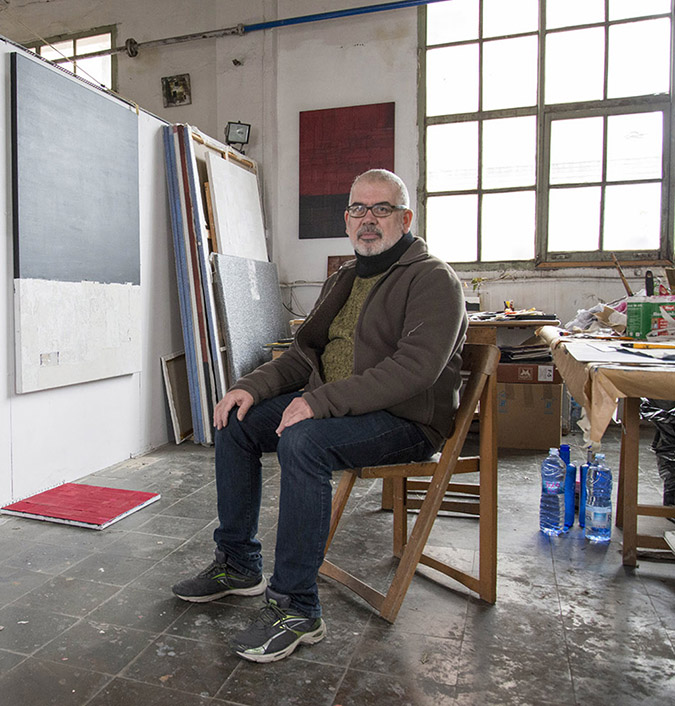
Juan Francisco in his studio. He is one of the longest standing artists in residence at La Escocesa, fighting for artist space and preserving the heritage of the barrio.
«IT'S IMPORTANT TO FIND SOLITUDE BEFORE I START A NEW PROJECT.»
Rina Ota
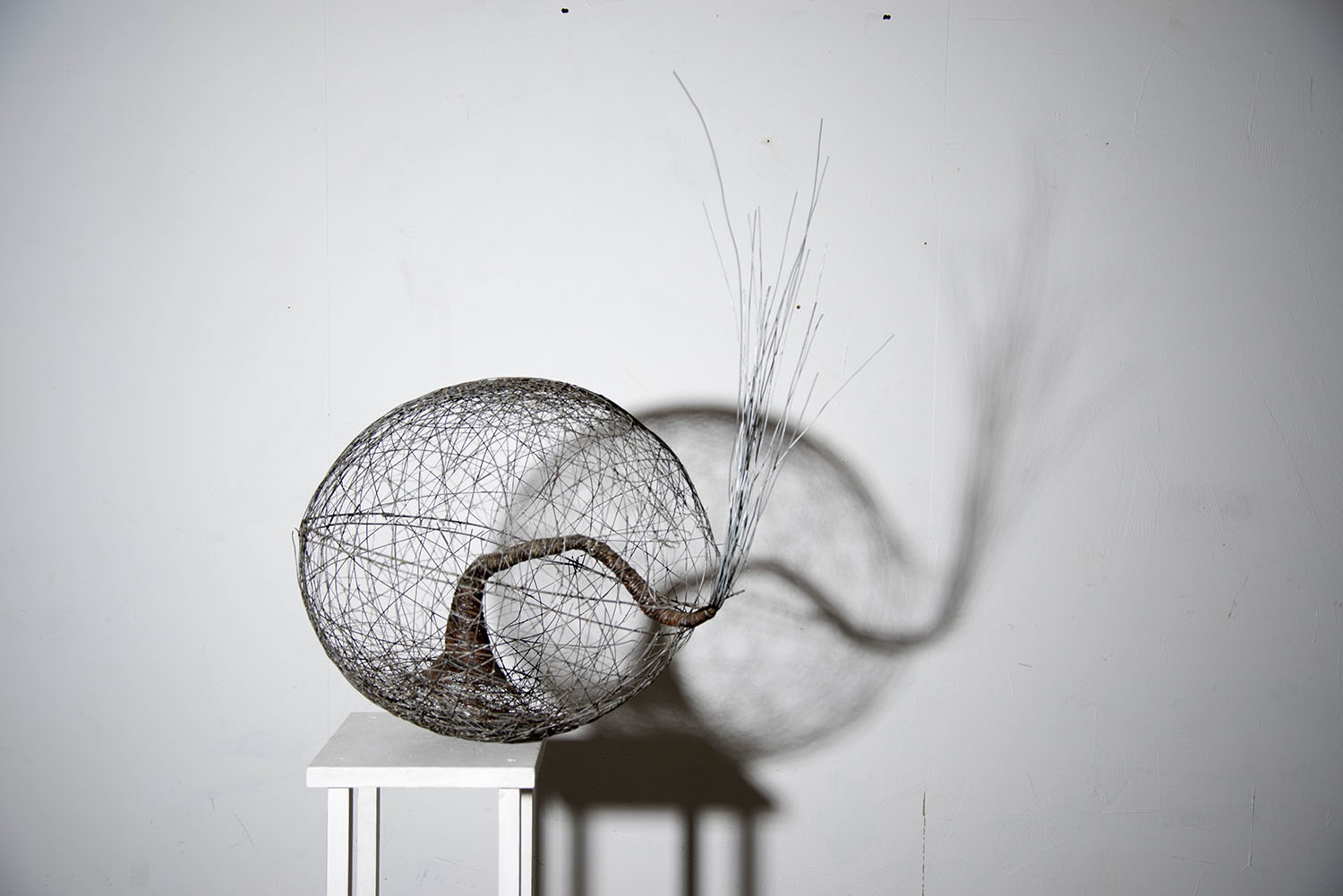
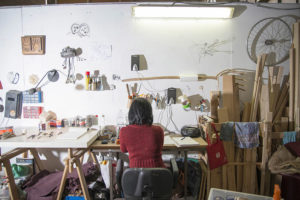
Rina Ota, a Japanese mixed-media artist, consolidates and strengthens her knowledge of art at the centre, where she has worked for the past three years. I find her balancing precariously on a ladder while reaching to tweak an installation piece in the form of delicate, dangling shards of glass. It’s designed to evoke the participation of onlookers through the creation of sound. Like many artists in the city centre, space was an issue for Rina. La Escocesa was well respected in the community, so she gave it a try. Working at the complex has radically changed her perception of the arts industry.
Rina in front of her installation outside in the hallway of La Escocesa. Now, this woman does installations, she creates sculptures, she paints and she is also into the performing arts - multi disciplinary in the truest sense.
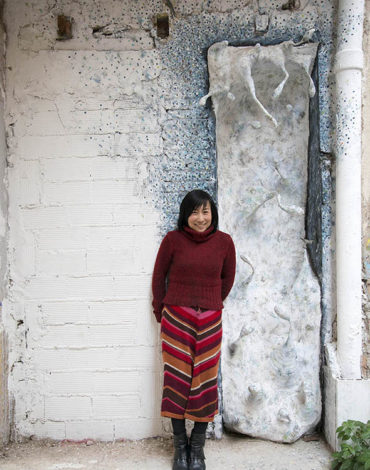
“When I arrived, I had a very ‘classic’ understanding of art. I expected to follow the traditional route by selling work in a gallery, but it doesn’t work that way anymore – it’s all about forging new connections. In this economy, you have to be pro-active. There’s a strong network of artists and we all help each other out, but I do worry about the constant changes that affect Poble Nou. La Escocesa might risk losing its spirit and become gentrified, but for the moment we’re safe. Either way, I’m not sure I want to stay around to see that.”
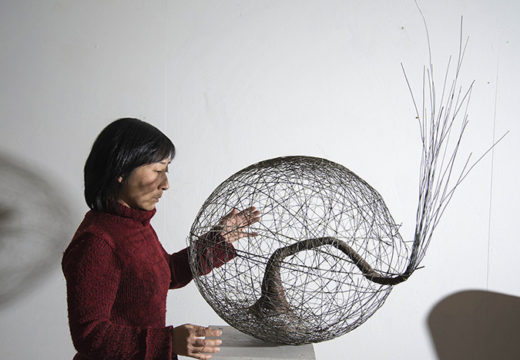
This wire sculpture took her roughly three months to complete. Rita says that when she starts a new project she has to carefully listen to herself, and at times she also talks to herself aloud.
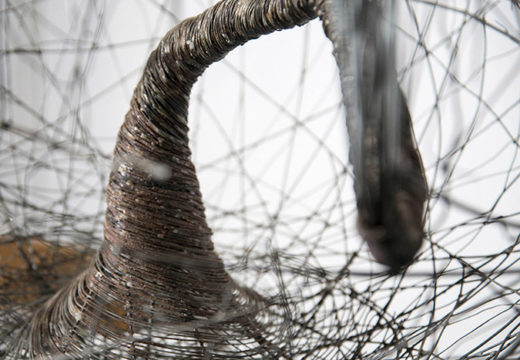
A mural in the backyard by Jerome from Hello Monsters
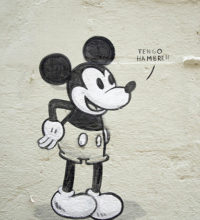
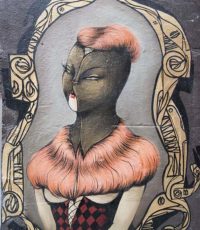
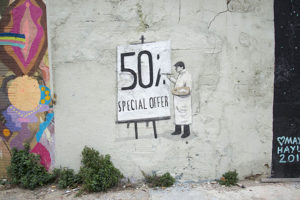
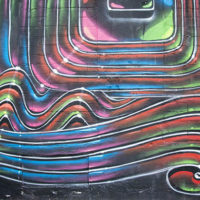
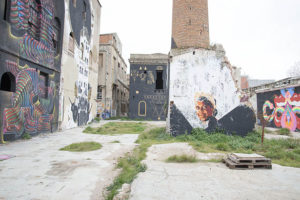
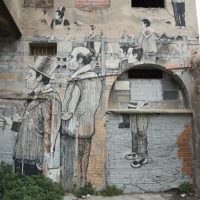

1 By Escif 5 By Escif
2 By Btoy 6 By tizne y Asier
3 By Miss Van and Ciro 7 By Spok
4 By Daniel Muñoz 8 By Escif
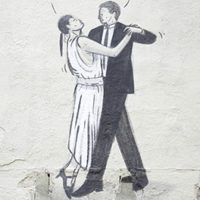

In a landscape of ruins, the collective built new foundations, but the council might still reclaim the complex and convert it into much more sophisticated studios in a similar way to Hangar, just blocks away.
After guiding me through the studios, Juan Francisco shows me another perspective. We stand on the roof of the building against a landscape of skyscrapers and tired factories, a post-apocalyptic scene if it weren’t for psychedelic Mandala paint-strokes swirling all over the floor beneath our feet. “We work within our own micro-worlds, but there is so much diversity and variety in Poble Nou that I’d never leave the neighbourhood. I’ve created my best work here,” he says.
It’s such unique environment that I have to wonder whether La Escocesawould be so vibrant today had the complex not endured its difficult past. I ask Juan Francisco if he’d fight again to keep the space but his laugh echoes across the brick walls surrounding us. “I can’t say ‘La Escocesa is mine!’ and stay for the sake of it. It’s not about fighting; it’s about having established who we are. I’m proud to have participated in its conservation, to turn it into the fabrica de creación that you see here, but it’s a project far greater than I am and one day we might have to leave. It’s bittersweet, but that’s life.”
In awe about the studio of LaBuenayLamala. Those colors seem like they come flying at us. Some of her artworks remind us of Calder, but it is a complete 21 century reinterpretation.
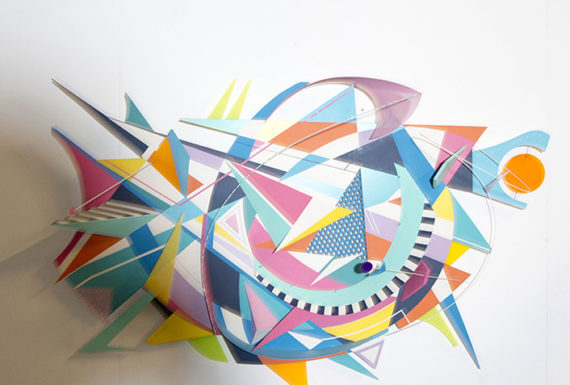
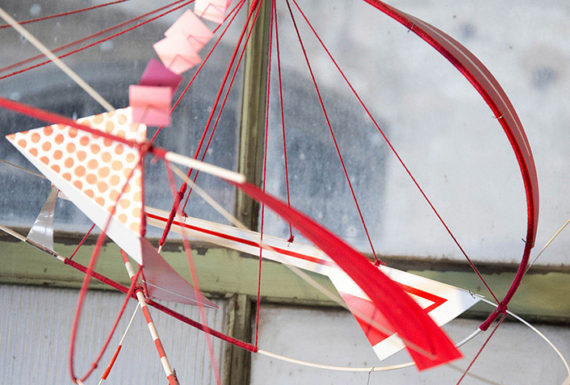
The beautiful flying artworks of La Buenaylamala have a poetic and multi dimensional feel to it.
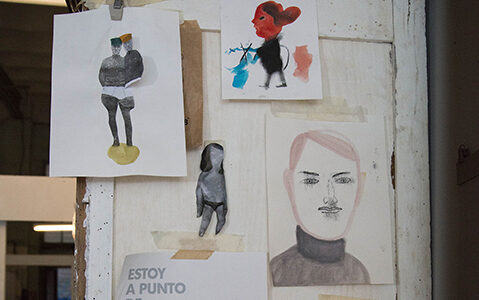
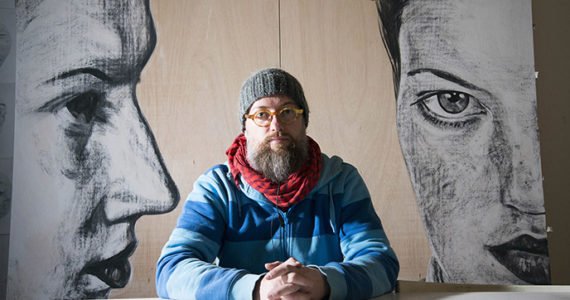
DIEGO, WHAT’S IT LIKE TO WORK AT LA ESCOCESA?
I feel very fortunate to have my space here because it’s very difficult to find an affordable studio in Barcelona. La Escocesa also offers exposure and networks within the artistic context of the city. Sharing experiences with other fellow artists is enriching. There are always new shared opportunities and projects arising - exhibitions, exchanges and publications. The council allows us to use the factory but it doesn’t invest in its maintenance and upkeep. Unfortunately [in Spain], the cultural and artistic industry has become very politicized and bureaucratic which makes it difficult to self-manage without lots of red-tape, but we try to be as self-sufficient as possible.
«I explore human emotions, identity and the relationship dynamics of power and powerlessness.»
DIEGO MALLO
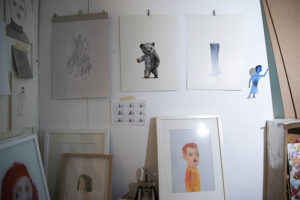
In the studio with Diego Mallo. He is a die hard illustrator with his very own style and works for international magazines, book publishers and agencies. In the past few years, he has found the passion for creating larger paintings.
HOW WOULD YOU DESCRIBE YOUR WORK AND HOW HAS IT EVOLVED SINCE STARTING AT LA ESCOCESA?
I use a broad range of mediums, from painting and sculpture to drawing/illustration and experimental animation. I explore human emotions, identity and the relationship dynamics of power and powerlessness. I use emotional anaesthesia as a starting point to question the unspoken and the quotidian, bringing to light subtle and perverse relationships that connect us. Many of my images represent human bodies or faces that interact with space, lacking any type of scenography. Being at La Escocesa has enriched my work and I’ve already enjoyed three residence exchange grants abroad. I’ve been to Bulgaria and Manchester as part of the exchange program and last November I spent time in Zurich.
All of these intercambios have been extraordinary experiences, both on a human and on an artistic level. Even though they were short (six weeks) the allowed me to establish contact with very different art scenes and cultural contexts. The residencies allowed me to develop projects ranging from performance, drawing and animation and, in the case of Zurich, to work with an element completely unknown to me until then:Baugespanne (an construction profile used prior to constructing)
WHAT OPPORTUNITIES DO YOU SEE IN BARCELONA NOW?
Artistic production and design centres are springing up everyday. The neighbourhood is being equipped with cultural spaces and many new striking places have appeared related to creativity and innovation. Unfortunately, the abundance of new spaces for art creation hasn’t resulted in collaboration as in other countries where I’ve been, like the UK, Germany, Switzerland, etc where both private and public entities network with each other, communicate and manage joint initiatives. My impression is that in other countries there is more funding and, even more importantly, they encourage an environment more open to artistic initiatives and/or self-management.
Or the last two years we’ve become established as part of the Poblenou Urban District, an association managed by the gallery La Plataforma, attempting to unify different activities in Poble Nou, both in terms of creativity and culture as well as leisure and gastronomy.
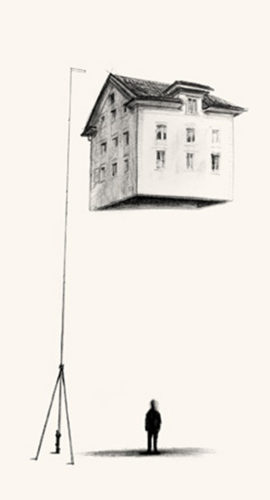
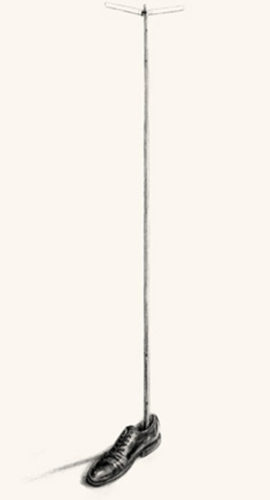
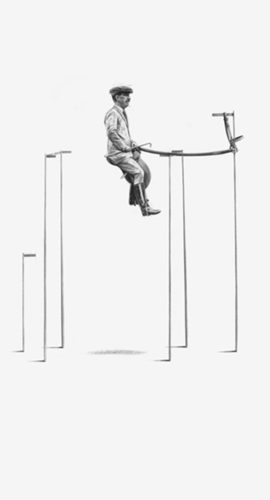
The series 'Baugespanne' has started in Zürich, Switzerland, where Diego was an artist in residence for a while.
Pencil and charcoal on paper
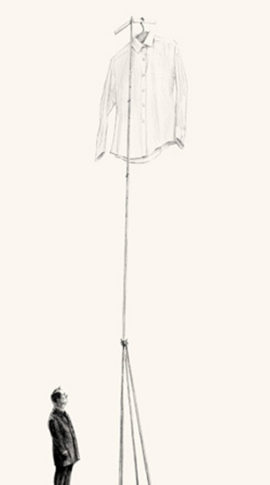
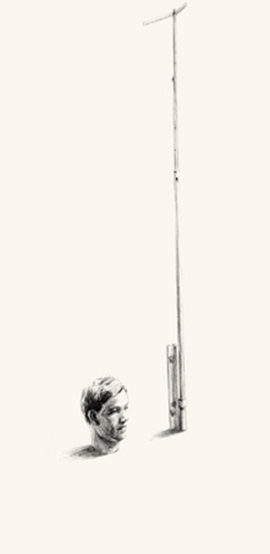
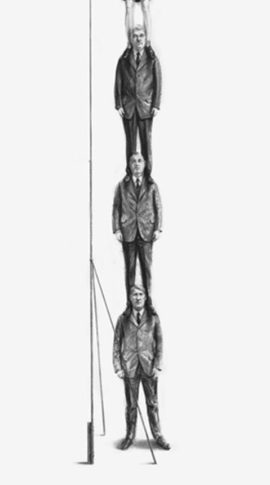
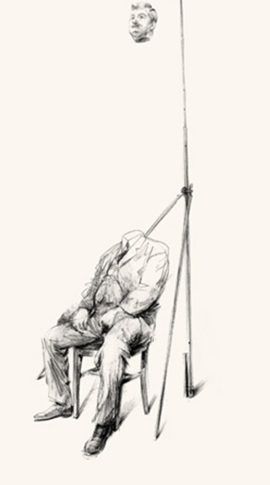
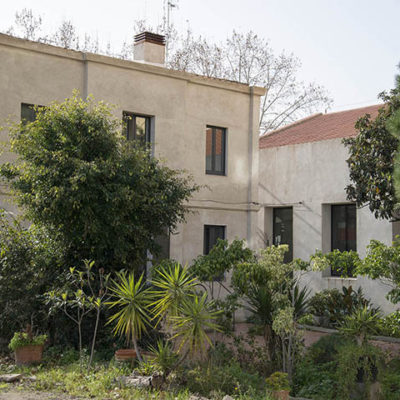
HANGAR BEGAN ITS LIFE AS ONE OF BARCELONA’S FOREMOST TEXTILES FACTORIES, CAN RICART, PRODUCING SUNSHADES AND TEXTILES FOR THE LEISURE INDUSTRY. LATER, A GROUP OF CREATIVES – OVER FIFTY ACROBATS, PAINTERS AND PERFORMERS KNOWN AS THE MAKABRA COLLECTIVE – SET UP STUDIOS IN THE ABANDONED FACTORY COMPOUND BUT WERE FORCIBLY REMOVED DURING THE CONSTRUCTION FEVER OF 2006, AND THE FACTORY ITSELF ONLY NARROWLY ESCAPED THE DEMOLITION THREAT THAT HOVERED BECAUSE OF 22@.
BUT WHILE LA ESCOCESA BROKE OUT OF THE 22@ MOLD, CAN RICART, NOW KNOWN AS HANGAR PRODUCTION CENTRE, IS A PRODUCT OF THE COUNCIL’S NEW CULTURAL STRATEGY IN POBLE NOU.
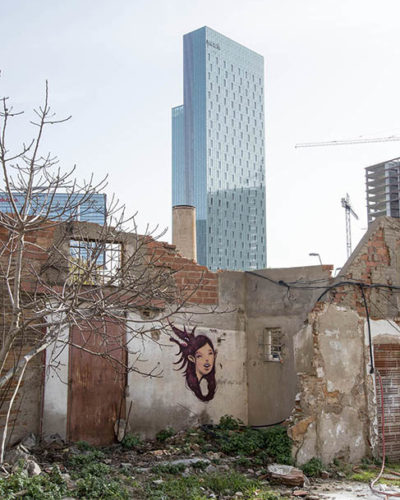
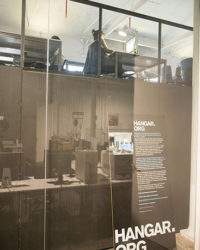
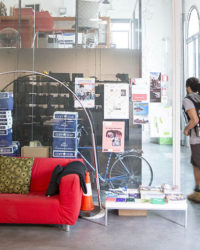
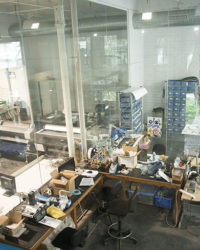
Hangar is well equipped with computer labs, cutting rooms and printing facilities. In many ways, this place could be a poster child on how a former factory can be effectively used.
Today Hangar is a renovated new-media centre that includes fifteen individual studios, a media lab, equipment-rental service with in-house technicians and a consultancy with international exchange programme. The site regularly hosts mini-festivals and audio-visual performances, drawing crowds from the centre and beyond. Subsidized by the Catalan government and the city council, Hangar focuses on production and research through an infrastructure of grants and artist training workshops.
Canadian-born Giuliana Racco and her Italian partner Matteo Guidi have just been granted a two-year residency at Hangar after completing a three-month stint. In their work they explore themes of survival in the face of harsh limitations, which is exactly what attracted them to Poble Nou.
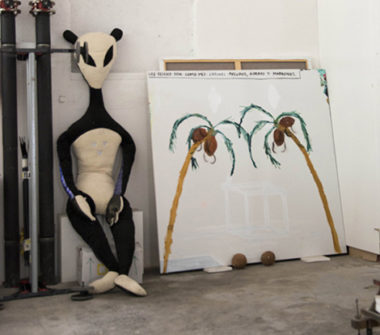
“We needed a suitable place to reconcile the research we’d done in Israel and Croatia,” Giuliana says. “The centre is becoming overrun by tourists, but they don’t get to Poble Nou. Different creative realities are forming here. It’s extremely important to continue producing work and creating original projects here that aren’t reliant on tourism,” says Giuliana.
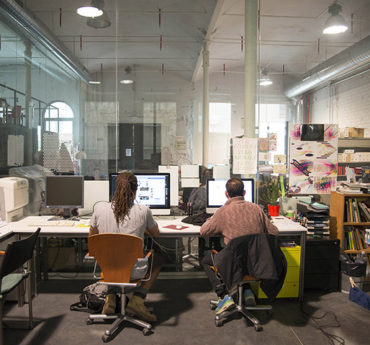
Hangar’s international reputation means that competition is increasingly tough, but there is a strong sense of camaraderie and assistance within the centre. Giuliana tells me. “We’re actively involved in the community at Hangar, with meetings and presentations every week. It helps us understand how to maximize our time and increase productivity.”
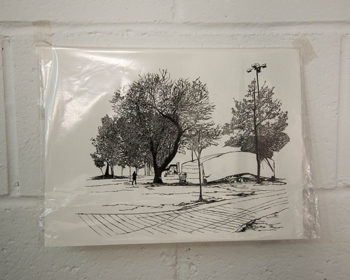
Giuliana and Matteo at work in their studio. At times they collaborate on projects and find common ground with their artistic direction.
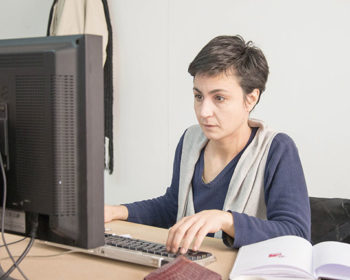
With a background in graphic design and anthropology, Matteo investigates imaginative practices in tightly controlled environments as a means of escapism and survival. Giuliana, trained in visual arts and linguistics, is concerned with narration and movement. Hangar’s systematic character is the perfect springboard for the pair, whose studio is neat and structured. For their current collective project, “The Artist and the Stone,” they both spent 7 months in the West Bank researching concepts of immigration, bureaucracy and citizenship.
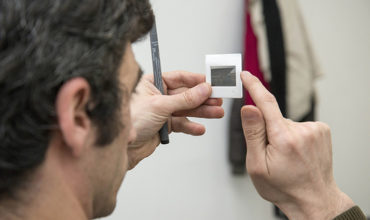
They plan to compare the technical implications of moving an artist versus shifting 10,000 kilos of stone to Europe. Which is more complex to move? Life in the West Bank provides a unique set of circumstances because special permissions are required to enable the passage of both objects and people. The scale of this multimedia project is vast, with the goal of gaining deeper insight into the ramifications of survival in the political context of a globalized world.
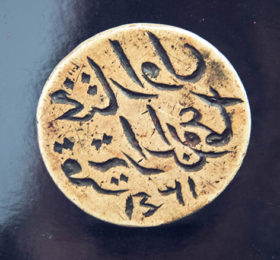
This project consolidates the research that Matteo undertook in Italian maximum-security prisons, Cucinare in Massima Sicurezza. During his residency there, he met prisoners who repurpose everyday objects to overcome the suffocating order of life behind bars. A coffee-maker is used to mash potatoes or crush nuts, a razor-blade chops garlic.
These simple acts allow prisoners to reclaim a semblance of power and identity over their lives. “Prisoners live a very passive life behind locked doors and barred rooms, but they can rebel against these confines by taking control of the way they prepare food. Whether in the middle of the desert, a refugee camp or in prison, food is the one constant for survival – a basic human need,” Matteo says. “Cooking and sharing a meal becomes a cathartic experience for them.”
At the core of these projects are political issues of social engagement and identity. Overcoming limits also resonates with Giuliana and Matteo on a personal level. “Matteo was convinced we’d find new energies and opportunities here because of the crisis. We’ve been forced into becoming more resourceful because of limited opportunities; it’s given us a real urgency to create. We have to keep creating to keep the economy going.” It seems that Matteo and Giuliana’s art imitates life.
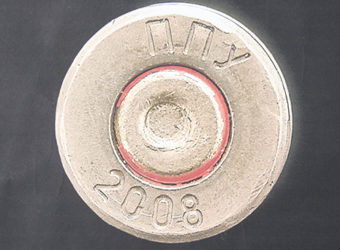
Creation centres such as Hangar and La Escocesa are a soothing antidote to the apathy that can spread from bleak economic prospects. These workspaces help artists to break through the difficulties of economic instability to drive progress through well-organized and pro-active residences, far removed from dizzying tourist traffic of the centre.
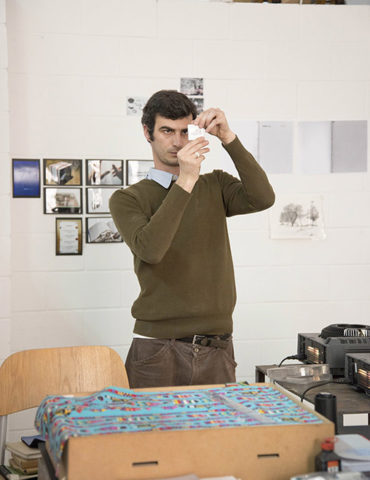
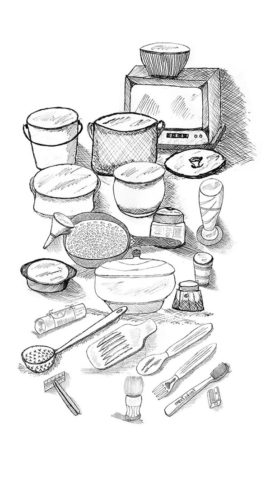
EDITED BY MATTEO GUIDI
DRAWINGS BY MARIO TRUDU
first published with Stampa Alternativa / Nuovi Equilibri
CUCINARE IN MASSIMA
SICUREZZACOOKING IN
MAXIMUM SECURITY PRISON
IS A COOKBOOK CONCEIVED AND DEVELOPED WITH DETAINEES OF HIGH SECURITY PRISONS THROUGHOUT ITALY, INCLUDES CULINARY METHODS WHICH APPLY THE LIMITED AVAILABLE RESOURCES FOUND WITHIN PRISON CELLS. EACH LIST OF INGREDIENTS IS PRECEDED BY A LIST OF NECESSARY TOOLS. KITCHEN UTENSILS, GENERALLY OMITTED IN TRADITIONAL RECIPE BOOKS UNDER THE ASSUMPTION THAT THEY ARE READILY ACCESSIBLE, BECOME THE CONNECTING THREAD OF THE ENTIRE WORK. THEIR CONSTRUCTION AND USES ARE DESCRIBED AND ILLUSTRATED: A BROOM HANDLE BECOMES A ROLLING PIN, SHOELACES TIE UP ROLLED PANCETTA FOR SEASONING, A TELEVISION SET PRODUCES THE HEAT NECESSARY FOR THE RISING OF PIZZA AND BREAD DOUGH IN THE OTHERWISE CHILLY CELLS AND, MORE INGENIOUSLY, CUPBOARDS AND STOOLS ARE TRANSFORMED INTO OVENS.
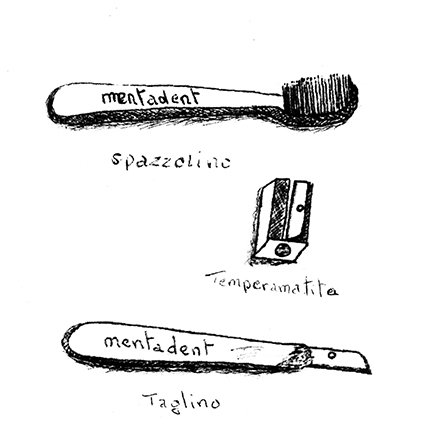
HOW TO CONSTRUCT AN OVEN
Empty the wall cabinet, wash it and disinfect it well, perforate the bottom with a red-hot nail heated on a cooking element, make sure the holes are of a diameter suitable for screwing and unscrewing the camping stove, take four empty beer cans, arrange them in order to rest the baking tray to be used for cooking. For a more functional oven, collect the foil lining from cigarette packs and line the inside of the cabinet.
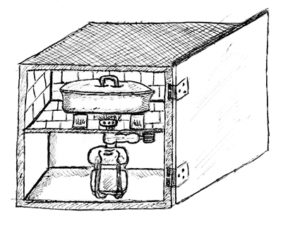
HOW TO CONSTRUCT A REFRIGERATOR
Find five styrofoam containers used for packaging mozzarella and collect a considerable amount of foil lining from cigarette packs. Carefully cut the bottoms of four of the styrofoam containers and glue them one on top of the other with vinavil, make a lid using the bottom of the last container and line the inner and outer sides of the structure with the aluminum. Your cooler bag is now ready. You will require a freezer in your section to freeze the water bottles needed for your fridge.
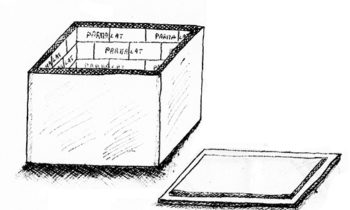
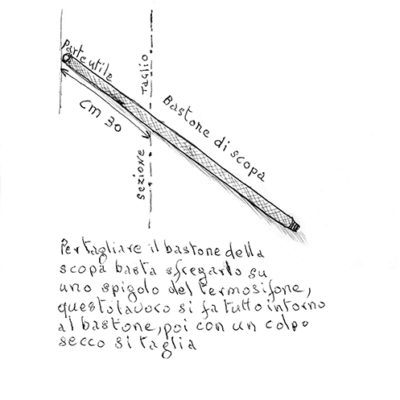
RECIPE
THE BREAD FROM ROOM 263
EQUIPMENT
broom handle, camping stove, antiadherent saucepan, salad bowl, television, small pot, small table, plastic knife, round cake plate c. 20 cm diameter.
INGREDIENTS
1 kg “00” flour
1 tsp. salt
1 cube of brewer’s yeast.
Matteo Guidi is a conceptual artist with a background in visual communication and ethno-anthropology. Together with detainees of high security prisons in Italy, such as Mario Trudu, he developped a cookbook including methods which apply the limited available resources found within prison cells. The drawings and recipes are excerpts from the cook bookthat came out of this project.

PROCEDURE
Evenly cut a piece of broom handle measuring 25-30 cm in length, clean it well and immerse it in a boiling pot of boiling water to eliminate any impurities – it will serve to roll out the dough. Place the flour, a teaspoon of salt and the yeast (diluted in warm water) in the salad bowl to avoid dirtying the room with flour, combine all the ingredients until one piece is formed, place it on a table and continue to work the dough until it is smooth and lump-free, put it back in the salad bowl and cover well. Allow the dough to rise by placing it on a television set that has been turned on for about 2 or 3 hours, depending on the heat that it emanates. Remember to close the window to reduce air currents. Cut the dough into 80 g balls and roll them out with the broom handle-rolling pin, place the dough on the cake tray and trim the edges so that all of loaves will take the form. Cook them one at a time in the saucepan on the camping stove. They should swell like balloons. Preferably preserve in an unbroken nylon bag so that they may remain soft.Excellent with cold cuts and cheese. Also very good with meat.
apparatu
SHATTERING
IDEAS
OF
ARTISAN
CERAMICS
Photography Stefan Jermann
Text Natasha Drewnicki
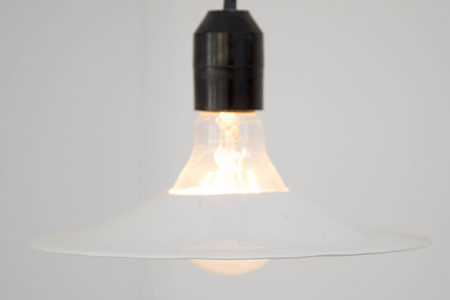
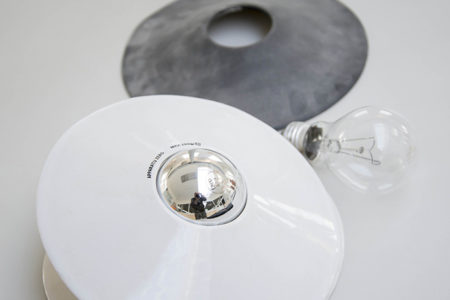
Xavier Mañosa constantly invents new ideas. This is a prototype of a simple lamp shade that sits on the actual light bulb.
XAVIER MAÑOSA HAS BEEN HERALDED AS ONE OF SPAIN’S BOLDEST CERAMICISTS, BOASTING COMMISSIONS FROM NIKE, CAMPER, ALESSI AND VITRA AND EXHIBITIONS IN NEW YORK, TOKYO AND STOCKHOLM. HIS LABEL, APPARATU, BLENDS THE PRIMAL ART OF CERAMICS WITH CONTEMPORARY DIGITAL CULTURE, INNOVATIVE PROCESSES AND A HEALTHY DOSE OF CULTURAL REFLECTION.
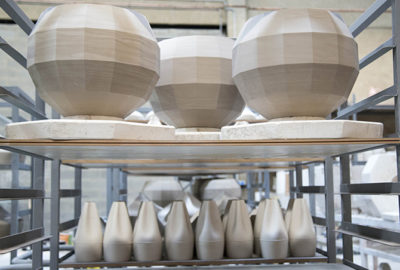
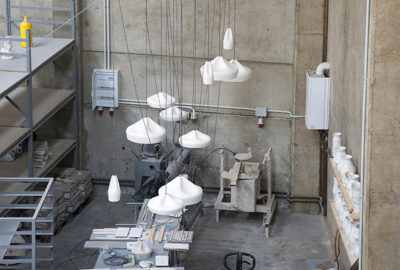
The new workshop where the signature lamps for MARSET are being created and hand finished.
When Xavier Mañosa lived in Berlin and started making ceramic figurines to sell at the Boxhagener Platz flea-market, he was unaware it would unlock a passion that was already part of his DNA.
Xavier had grown up surrounded by the warm earthiness of clay, potters’ turnstiles and kilns of his parents’ ceramics business in Barcelona, but rejected ceramics as a professional pathway until he needed a constructive escape from creative inertia.
While searching for a stable job to supplement his paltry income, he set up a pottery studio to create small, quirky ready-mades such as a traffic cone, three dimensional vase-blackboard and water balloon. “I didn’t think about the first pieces much before making them. They were quite naïve,” he says. A few months later, a London gallery invited him to take part in a group exhibition. “It all happened so fast - I felt like a rock star. From there, I made a website and started creating my own line.”
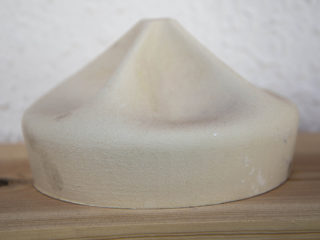
In the office of Apparatu with models and various books that serve as inspiration.

«IT'S VERY IMPORTANT TO FIND A BALANCE WHERE THE MATERIAL FEELS COMFORTABLE AND IT SUPPORTS THE DESIGN.»
The exhibition cemented his passion and he boomeranged between the Berlin studio and his parents’ in Barcelona for a few years, but soon realized he would need a fixed base. “I realized that, to be serious about ceramics, there was still much for me to learn." He returned to Barcelona permanently in 2009, which is when his father taught him about the alchemistic qualities of clay and suitable methods of production for different pieces. “It’s very important to find a balance where the material feels comfortable and it supports the design,” he tells me.
Working with family presents a curious dynamic. While his parents focused on traditional methods – and what sells – for the sake of practicality, Xavi is the innovator, using digital software to create molds. He often experiments with bizarre combinations of raw materials such as porcelain and silicone, a world away from the bourgeois blue and white china teacups usually associated with the material. He credits his approach to university training in Industrial Design. Mañosa has also brought other hallmarks of his generation, branding and identity, into the business, aiding its visibility in today’s global marketplace.
The Apparatu label reflects Xavi’s reductionist approach to design. The name was born from the German word “Apparat” meaning appliance, and "aparatu", Catalan for instrument - a marriage of“poorly written Catalan and poorly spoken German!” he says, jokingly.
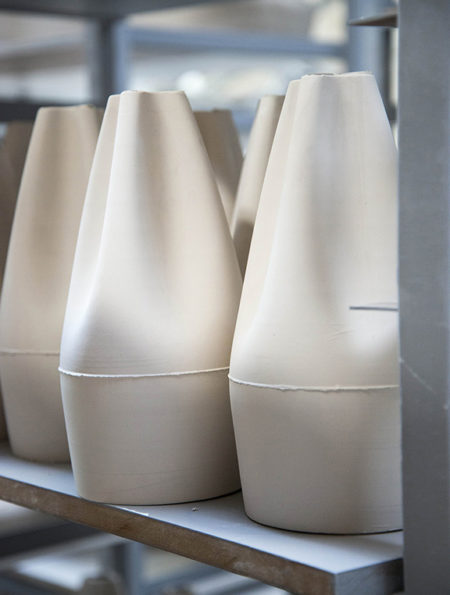
Lamps right before going into the ceramic oven for hardening and drying.
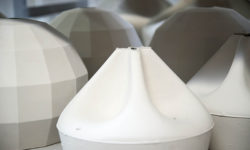
Since MARSET picked up the signature line «Pleat Box» Xavier developed, production is at full swing. They produce anywhere from three to sixthousand units and the top model is also available with a gold plated inside. Everything is based on a completely handmade process.
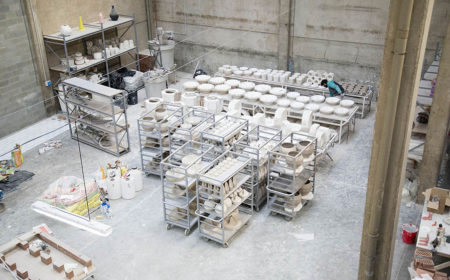
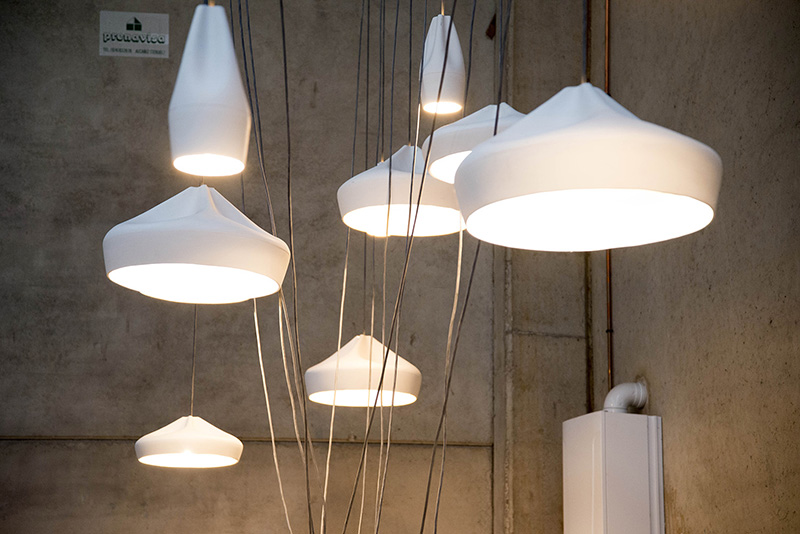
«EVERYTHING HERE IS HANDMADE, THERE IS NO AUTOMATION. WE'RE ARTISANS.»
Xavi is unexpectedly spritely for someone whose profession demands a calm hand, darting around the studio to showcase Apparatu’s various projects in progress. A mop of chestnut curls tumble over his thick-rimmed glasses as he bounces from one conversation to another with unbridled enthusiasm. The walls and floor of the studio are coated in cracked beige clay - it’s a dusty workspace, a ceramic desert. We hear a gentle clackclackclack of pots somewhere behind us.
Rustic bowls with lacquered interiors line the table. Over on the drying rack, giant disco balls appear to have been reincarnated as paper-thin, giant orbs. Several Pleat Box lamps dangle from the rafters with tightly pinched necks, ceramic interpretations of creased cloth. Pleat Box lamps are Apparatu’s best seller, he says, distributed through bespoke high end lamp-specialist MARSET and fetching well above a thousand Euros per piece.
He shudders when I ask if he would ever consider manufacturing for a large-scale corporation. Ikea, for example? “No, because that would mean producing in an automated process with extremely high units. Limited editions are an important part of the production process, giving exclusivity to the client.”
The workshop of Apparatu in full production. An assistant of Xavier is preparing the casting molds.
«SOME THINGS SEEM LIKE ACCIDENTS, BUT ACCIDENTS HAPPEN BECAUSE YOU ARE INVOLVED. I AM CONSTANTLY THINKING HOW TO IMPROVE MY WORK.»
Xavier Manosa
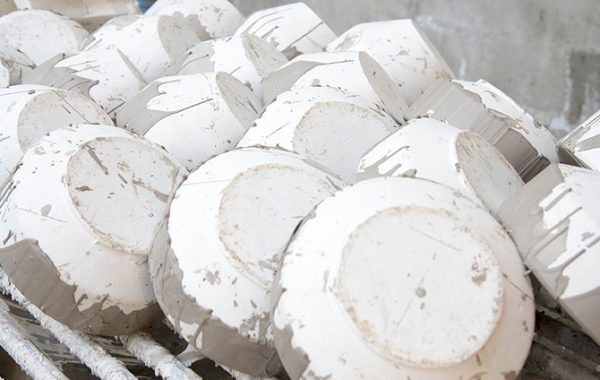
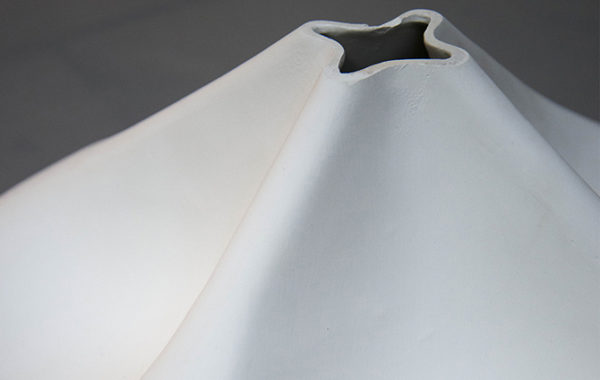
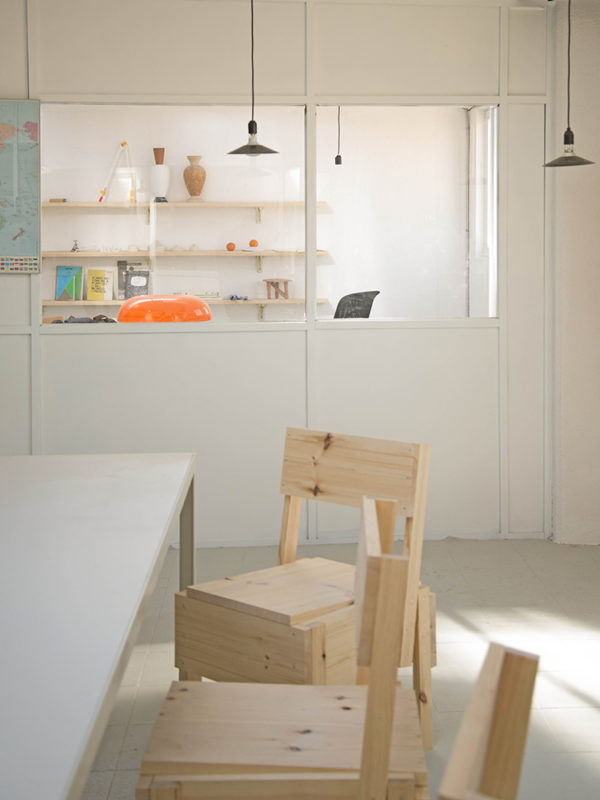
The Apparatu office which Xavi shares with his parents in a grand warehouse. The entire production is housed under one roof.
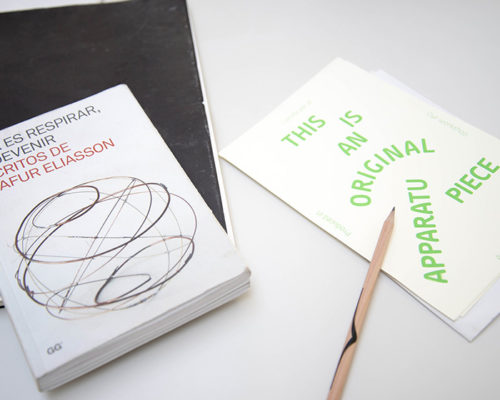
Xavier and his father 'papa' Mañosa at the new Apparatu workshop taking a break. While Xavi is the inventor and brain of Apparatu, one clearly senses that family is playing an important role in the business.
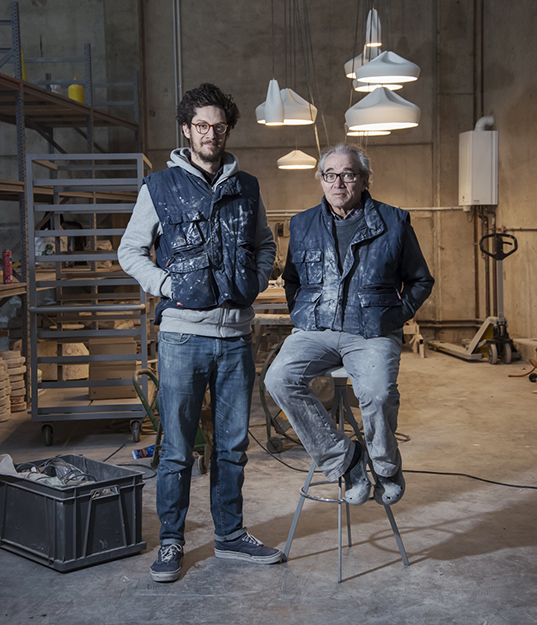
“Everything here is handmade, there is no automation. We’re artisans,” Xavi assures me, proudly. Many of the pieces are imperfect – a scratch here, a wobble or bloat there. Molds have a life cycle of eighty uses, meaning that pieces expand and change shape as the molds age.
On an industrial level, these quirks would render the pieces faulty, but in the context of an artisan workshop they only add to its authenticity, each imprinted with its own number. “Some things seem like accidents, but accidents happen because you are involved,” he says. “I am constantly thinking how to improve my work.”
Though artisan and digital methods of production might seem worlds apart, Xavi harnesses the trappings of digital life to push creative boundaries while respecting the capabilities of his medium and traditional methods of production. His work is both practical and beautiful, shattering our preconceptions of contemporary ceramics.
Home to tomorrow's
VISIONARIES
BARCELONA HOSTS A COLOURFUL ARRAY OF TOP NOTCH UNIVERSITIES, DESIGN SCHOOLS AND EDUCATIONAL PROGRAMMES, ATTRACTING AN INTERNATIONAL CROWD OF STUDENTS FROM EVERY CORNER OF THE WORLD. TO OUR ASTONISHMENT, THE SMALL NEIGHBOURHOOD OF POBLE NOU BOASTS THREE SCHOOLS THAT COULDN’T BE MORE DIFFERENT, THOUGH THEY ALL HAVE ONE THING IN COMMON: THEY ARE HOTHOUSES FOR ARCHITECTS, DESIGNERS AND MERCHANDISING STYLISTS OF TOMORROW, WITH GLOBAL OUTLOOKS AND ASPIRATIONS.
INSTITUTE OF ADVANCED
ARCHITECTURE OF CATALONIA
+ FABRICATION LABORATORY
IAAC
+ FABLAB
YOU WOULD NEVER GUESS THAT
THIS SIMPLE IRON DOOR IS THE
ENTRANCE TO ONE OF THE MOST
CUTTING EDGE ARCHITECTURE
SCHOOLS ANYWHERE. THE
INSTITUTE FOR ADVANCED
ARCHITECTURE OF CATALONIA
(IAAC) OFFERS A MASTERS DEGREE
THAT COVERS THE MANY FACETS
OF NEW FORMS OF PRACTICE IN
ARCHITECTURE AND URBANISM.
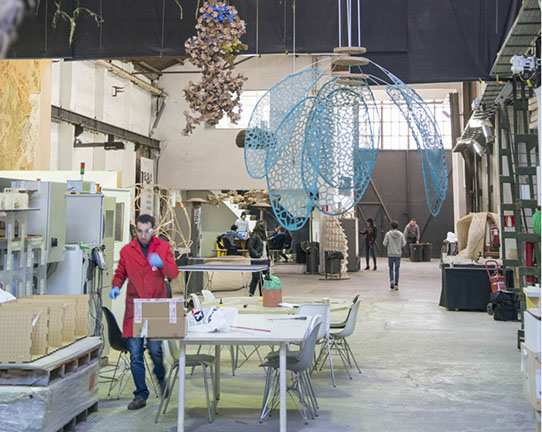
The school works with Massachusetts Institute of Technology (MIT) and various other top-notch universities in the US, collaborating with experts in engineering, sociology, anthropology and other disciplines. Working closely with IAAC is BCN Fab Lab, a member of MIT’s international community of digital fabrication laboratories, which uses the latest digital tools to create prototypes and scale models for architecture, construction and industrial design. Fab Lab laboratories all over the world share their knowledge of digital manufacturing via internet and video workshops. The idea behind this is that anybody can create anything when digital and technical knowledge is shared. Fab Lab uses advanced techniques and technologies which are made accessible to everybody and they are equipped with state-of-the-art equipment such as laser cutters, 3-D printers, and electronic components for artificial intelligence
IAAC is a 'hands on' school where students realize their own projects and have a huge workshop in order to complete their ideas.
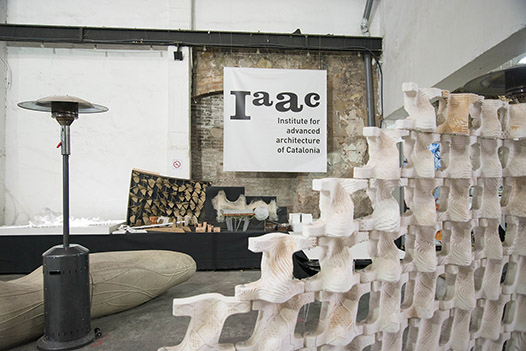
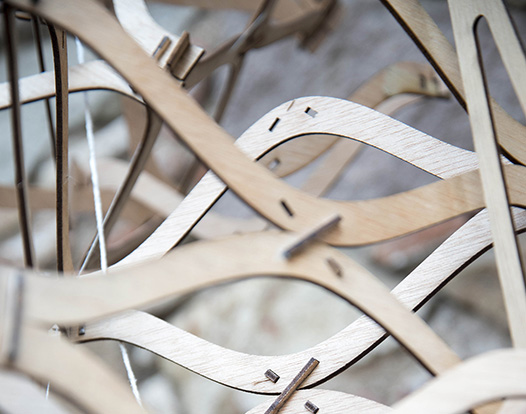

Many materials that are used are organic and traditional, but then they are placed in a high tech context where completely new fusions evolve.
I observe people in the Fab Lab in front of their computer screens. One is on a live video chat with somebody on another continent, probably exchanging project ideas for his Masters thesis. Then I spot a beautiful dress hanging on a wall, I get up close and try to figure out what the fabric is. A woman’s voice behind me asks if I need help and I meet Anastasia, the Fab Lab coordinator, who tells me she and Jin Shihui, one of the Masters students, made the dress. She goes on to explain that it is made entirely of natural hemp fibre and organic glue. The fibre is spun into some sort of hand built device, which Anastasia calls smilingly the ‘candy gun’, which then weaves the fibre into a dress. This is absolute catwalk material. I remark that it must be every fashion designer’s dream to invent a new technique to construct a dress. Jin Shihui and Anastasia just smile at me. Could be because they know they are onto something big here, could be that they are just having fun and playing.

»With the Olympic Games boom, Barcelona became a magnet for architects, urbanites, landscapers, cityscapers and maybe a few visionaries.«
And this school does have the feel of a big playground to me, though the faculty consists of world-renowned master architects and urban gurus such as Enric Ruiz-Geli from Cloud 9, Peter Cook, other architects from Japan and the US, and the list goes on. With the Olympic Games boom, Barcelona became a magnet for architects, urbanites, landscapers, cityscapers and maybe a few visionaries. Not all buildings are as jaw-dropping as Jean Nouvel’s Torre Agbar, which is now a landmark on the edge of the Poble Nou barrio, or the Media-TIC building in the 22@Barcelona project, the façade of which interprets how Gaudi would construct today. Some were clearly designed by anonymous architects to attract multinational companies, and all are bound to the budgets and demands of the construction companies

But, when walking around in Poble Nou, I feel that some of the newer buildings at least try to respect the neighbourhood’s heritage: a modern steel construction making a friendly nod to the old building next door, confirming that old and the new can co-exist and there’s no need to knock everything down. I hope that this spirit prevails at IAAC and that the students there aim not just for high tech inventions, but also on respecting our heritage, finding new ways to incorporate the old in modern living.
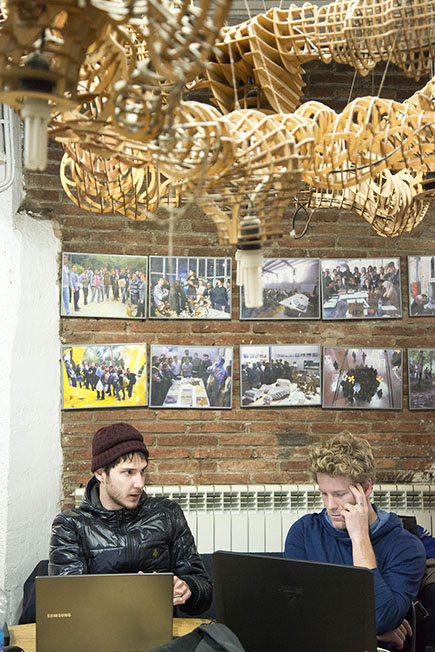
Students from all continents contribute to a colorful mix of ideas, inventions and visions that will shape tomorrow's future.
Anastasio Pistofidou (right) is the FabLab coordinator and Jin Shihui was a masters student and is now doing research. They together created the dress made out of natural hemp fiber and organic glue. The hand built "candy gun" served as a tool to create the dress.
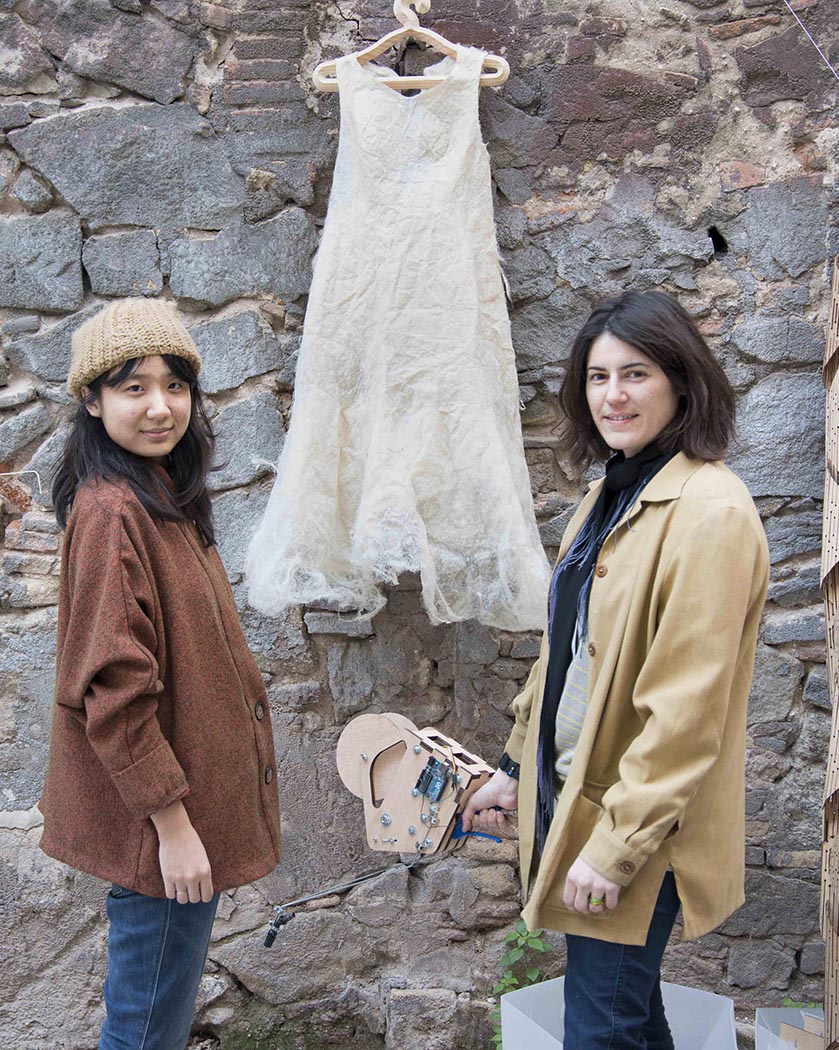
WHEN I LOOK UP THE TERM “MERCHANDISING”, WIKIPEDIA SPITS OUT THE FOLLOWING EXPLANATION: “IN RETAIL COMMERCE, VISUAL DISPLAY MERCHANDISING MEANS MERCHANDISE SALES USING PRODUCT DESIGN, SELECTION, PACKAGING, PRICING, AND DISPLAY THAT STIMULATES CONSUMERS TO SPEND MORE. THIS INCLUDES DISCIPLINES AND DISCOUNTING, PHYSICAL PRESENTATION OF PRODUCTS AND DISPLAYS, AND THE DECISIONS ABOUT WHICH PRODUCTS SHOULD BE PRESENTED TO WHICH CUSTOMERS AT WHAT TIME.”
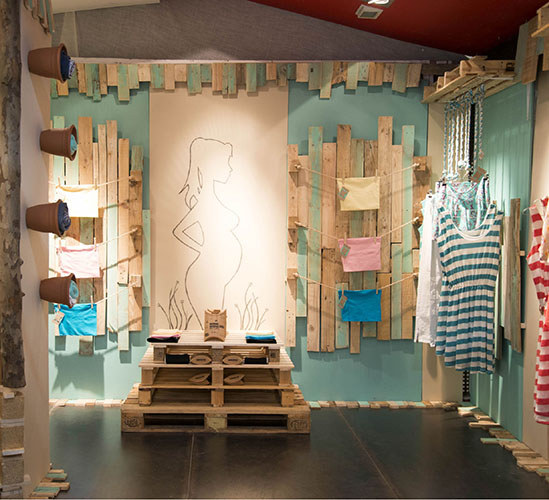
Left: a dummy store where students can apply their skills. Above: two Artidi students telling us about their experience as up and coming merchandising stylists.
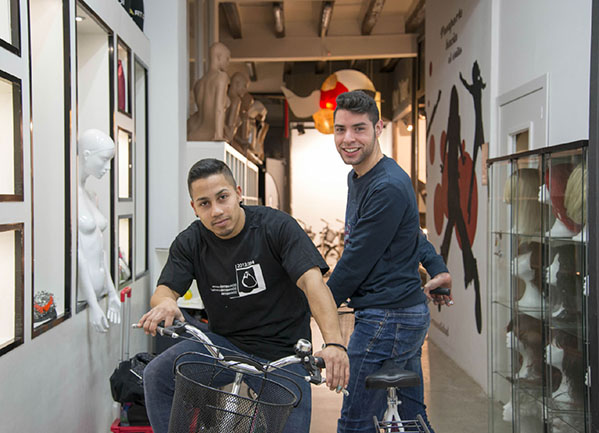
Dori, the communications manager at Artidi prefers the term, “window dressing” or simply put “visual merchandising”. The roots of Artidi go back to the 80’s and a course offered through Barcelona’s Chamber of Commerce by a group of people working in the industry. In 1995 a link with the University of Barcelona was formed and demand for the courses grew to the extent that Artidi, a school specifically for this discipline was founded, and it is still the only school in Europe of its kind. I was sceptical at first: a school for window display? But think about it: ever since shopping and visual stimulation have become permanent invaders in our daily lives, it has become more and more difficult to stop potential clients in their tracks.

Dori is the Director of Communications at Artidi and she also teaches some courses.
«BEING A WINDOW STYLIST IS NOT JUST ABOUT MAKING THINGS LOOK NICE. IT IS MUCH MORE ABOUT THE PSYCHOLOGY AND BEHAVIOUR OF THE POTENTIAL CLIENT AND THAT’S WHERE THE REALLY INTERESTING FACTORS COME INTO PLAY.»

After my first visit to Artidi I paid more attention to window design and what irritated me was that I stopped at totally unexpected and intriguing windows, but I also interrupted my walk for some that were really bad. The only difference was, I spent much longer in front of the ones that were really good – and they were also the ones where I might have been tempted to spend some cash.
Dori walks me through the facilities and tells me about Artidi’s approach to training: very much hands-on, as quickly becomes apparent. There are windows everywhere, just like real shops, and some of them are darned attractive. And that’s exactly the plan, Dora explains: “We have a “dummy shop” where our students are forced to create an entire environment within a very short period of time. Everything is totally realistic: this is not just theory, this is three dimensional.” There is a window colourfully arranged with a brand that uses a crocodile as its logo. Right next to it, I spot a mannequin wrapped in dollar signs. A bold statement, an eye catcher that makes you question your own behaviour for a second: “Money whore, shopping whore.” It made me laugh – a rare response to a window display for me.
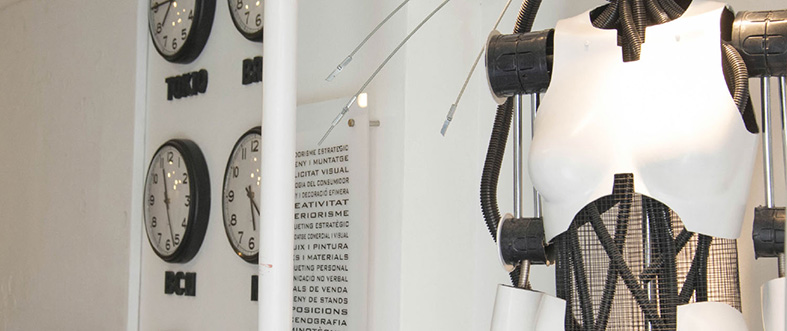
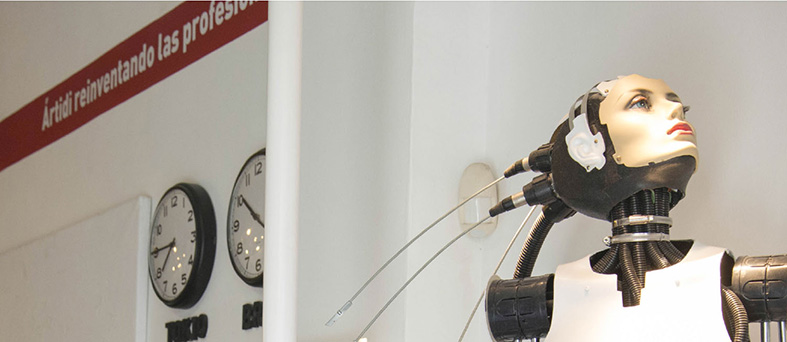
Artidi is a small school. The students all seem to know each other, and there is a real family-like groove going on. They greet me as I make the tour, with Dori answering my questions, and every now and then she stops for a quick chat with people we pass. Dori is a PR pro and she knows how to sell the school well, but you also get the feeling that she truly means what she says. Being a window stylist is not just about making things look nice. It is much more about the psychology and behaviour of the potential client and that’s where the really interesting factors come into play. I came away impressed by the school and if I had a shop, I’d invite Artidi to give it a makeover!
ARTIDI is a small school with very modern and minimalistic itneriors. The former factory has been transformed in a sophisticated manner to be used to educate future stylists.
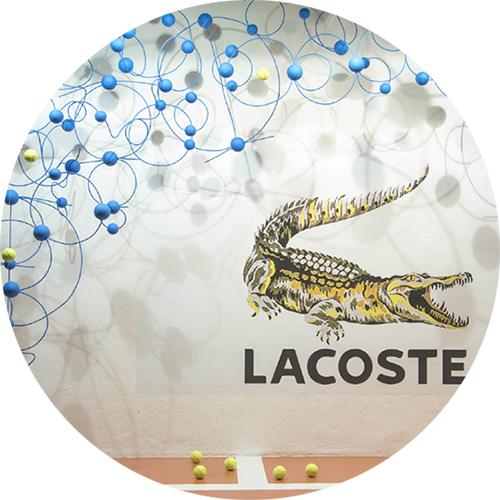
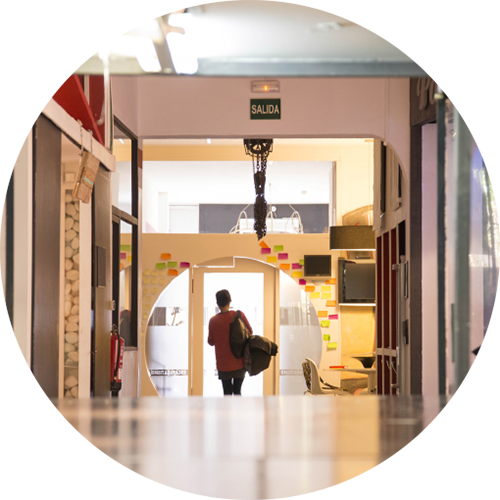
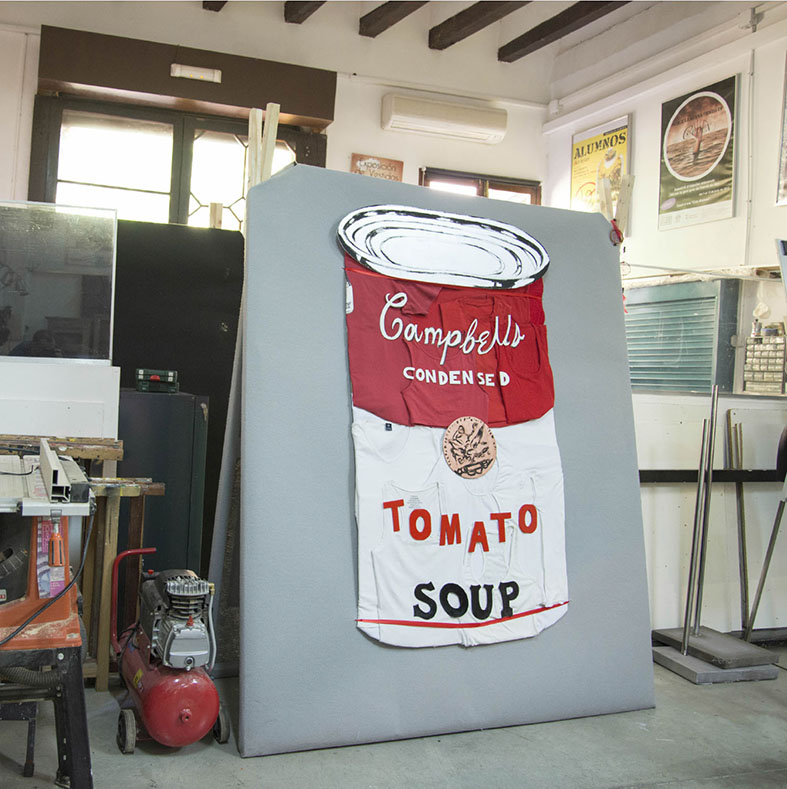
BAU IS BARCELONA’S COLLEGE OF DESIGN, OFFERING BACHELORS AND MASTERS DEGREES AND WORKSHOP CLASSES. NOT FAR FROM ARTIDI AND JUST ACROSS THE STREET IS LA PLATAFORMA, AN ART GALLERY FEATURING LOCAL AND INTERNATIONAL ARTISTS. THE GALLERY OWNER, CLAUDIA, TOLD US TO GO AND SEE BAU. THE SCHOOL WAS STARTED IN 1989 BY A CONSORTIUM OF DESIGNERS WHO WANTED TO PASS ON THEIR KNOWLEDGE TO FUTURE GENERATIONS. NOWADAYS BAU IS ON A PAR WITH TOP NOTCH DESIGN SCHOOLS.
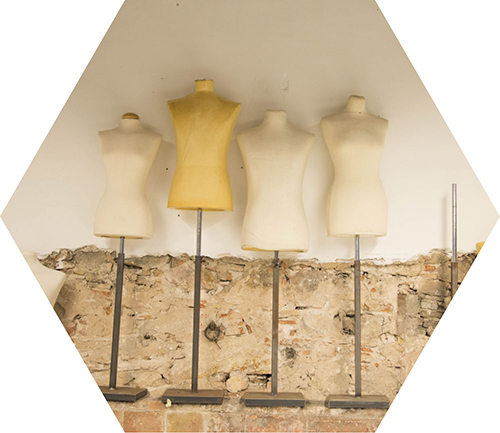
Though its main programmes are not as diverse as the School of Visual Arts in New York or the Art Center College of Design in Pasadena, Bau has a similar “cosmo” feel to it. Very international, very functionally orientated, yet like Artidi and IAAC, Bau also has a very homey and cosy atmosphere. There’s no hint of a factory-like school where future design brains are churned out like battery hens. Christian, the communications manager shows me around the place and after a while lets me explore on my own. Unfortunately, it’s holiday time at the moment so very few students are around. I take a seat outside on a little patio and for a moment dream about going to school here. Learning about all the new technologies, on top of a firm understanding of the basics. Sharing a totally exclusive environment with peers who have the same passion. And all that in such an inspiring neighbourhood as Poble Nou.
While contemplating my hypothetical studies at Bau, I spot two folks discussing a dress that they have designed or are about to. The world lies at their feet, they have the chance to completely reinvent themselves. They haven’t yet experienced that comfort zone feeling in which security — money, your own four walls and certain daily patterns, always remain the same. In many ways, their naïve non-jaded thinking opens their horizons and lets them turn visions into reality. Not taking risks is the biggest risk, because what you lose is not having tried.

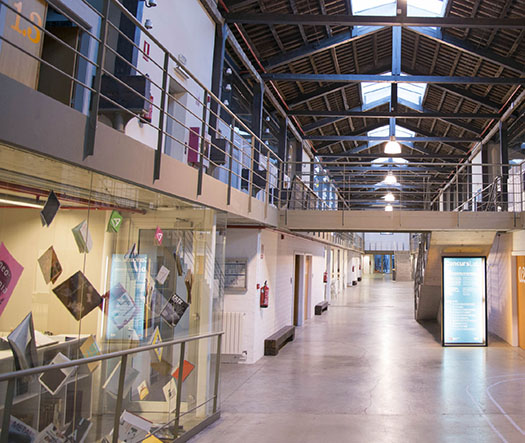
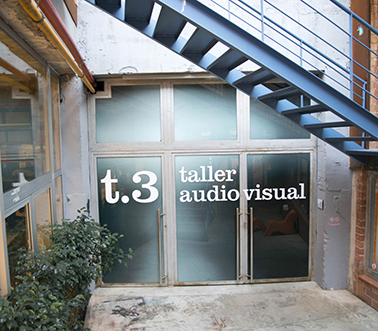
That’s what Barcelona and especially the neighbourhood of Poble Nou is all about. It’s a progressive place that grew at a rapid pace around the turn of the last century. Later, as the local manufacturing industry waned, the barrio turned into a ghost of its former self, but a dramatic resurgence of energy came with the Olympics. The city of Barcelona planned a complete modernisation of the area, which involved flattening most of the 800 factories, but a large number of people, including the younger generation, wanted to preserve the heritage of Poble Nou, while welcoming contemporary influences. Know where you come from, apply basic principles, and experiment with what the future has to offer. This is the philosophy that the people of Poble Nou as well as Bau, IAAC and Artidi share. And it’s one that will continue to shape the neighbourhood and inspire the students who are the visionaries of tomorrow.
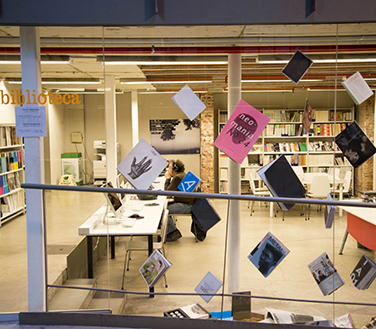
IMPRESSUM ISSUE 01
MIRUS IN BARCELONA
EDITOR IN CHIEF
& CREATIVE DIRECTOR
STEFAN JERMANN
MANAGING EDITOR
JUAN FABUEL
ART DIRECTION, DESIGN
TRUCE VISUAL COMMUNICATION
TEXT
AINA FAVA
NATASHA DREWNICKI
MANON HOLZER
MATTEO GUIDI
PROOF READER
BRIDGET WILKIN
GRAPHIC PIXEL BLENDER
BIANCA FREY FOR TRUCE
PHOTOGRAPHY
STEFAN JERMANN
BARTOMEU CALIX
ALEX DELANDERON
ARXIU HISTORIC
ILLUSTRATIONS
BIANCA FREY (maps)
PRISKA WENGER (icons)
IMAGE POST PRODUCTION
JUAN FABUEL
FOR LICENSING AND SYNDICATION OF ANY PHOTOGRAPHS, TEXTS OR MATERIALS DISPLAYED WITHIN, PLEASE CONTACT US.
IF YOU ARE A WRITER, PHOTOGRAPHER, ILLUSTRATOR, ARTIST, URBAN THINKER, VISIONARY, ENTERPRENEUR, FREQUENT FLYER OR A VISUAL CHALLENGER, AND YOU'D LIKE TO WORK WITH US OR HAVE SOME WONDERFUL LIFE CHANGING IDEAS YOU'D WANT TO PRESENT, PLEASECONTACT US AND LET US KNOW ABOUT YOUR EXISTENCE.
Copyright © 2014 MIRUS a TRUCE MEDIA GROUP company. All rights reserved. No part of this publication may be reproduced, distributed, or transmitted in any form or by any means, including photocopying, recording, or other electronic or mechanical methods, without the prior written permission of the publisher, except in the case of brief quotations embodied in critical reviews and certain other noncommercial uses permitted by copyright law.
